
About UsThe Numismatic Bibliomania Society is a non-profit organization devoted to the study and enjoyment of numismatic literature. For more information please see our web site at coinbooks.org SubscriptionsThose wishing to become new E-Sylum subscribers (or wishing to Unsubscribe) can go to the following web page link MembershipThere is a membership application available on the web site Membership Application To join, print the application and return it with your check to the address printed on the application. Membership is only $20 to addresses in the U.S., $25 for First Class mail, and $30 elsewhere. For those without web access, write to: David M. Sundman, Treasurer
AsylumFor Asylum mailing address changes and other membership questions, contact David at this email address: dsundman@LittletonCoin.com SubmissionsTo submit items for publication in The E-Sylum, just Reply to this message, or write to the Editor at this address: whomren@gmail.com BUY THE BOOK BEFORE THE COIN |
- WAYNE'S WORDS: THE E-SYLUM AUGUST 30, 2015
- NBS REGIONAL EVENT ORGANIZERS SOUGHT
- SKLOW MAIL BID SALE #26 CATALOG AVAILABLE
- NEW BOOK: A GUIDE BOOK OF BARBER SILVER COINS
- NEW BOOK: U.S. PAPER MONEY ERRORS, 4TH ED.
- NEW BOOK: AMERICAN JOURNAL OF NUMISMATICS 26 (2014)
- NEW BOOK: NUMISMATIC ARCHAEOLOGY OF NORTH AMERICA
- BOOK REVIEW: WHITMAN ENCYCLOPEDIA OF MEXICAN MONEY
- NNP LOCATES NEEDED COUNTERFEITING REPORT VOLUME
- ROBERT RHUE REMEMBERS ROBERT VLACK
- NOTES FROM E-SYLUM READERS: AUGUST 30, 2015
- MORE ON WILLIAM WEEKS
- MONROE F. WALTERS
- QUERY: BRASS CASTORLAND MEDAL INFORMATION SOUGHT
- 2015 ANA WORLD’S FAIR OF MONEY EXHIBIT WINNERS
- AN 1808 CONTEMPORARY COUNTERFEIT 2 REALES
- THE SAINT-GAUDENS CORNISH MASQUE PLAQUETTE
- LOUIS KAUFMAN'S 'TEMPLE TO BANKING'
- NUMISMATIC MENTORS AND STARTER BOOKS
- ON CLEANING VERDIGRIS FROM COPPER COINS
- EDWARD HULSEMAN'S CATSKILL BANK COUNTERFEIT
- QUERY: SOUTH CAROLINA OBSOLETE BANKNOTE HOARD
- LOST HAWAII SHORT SNORTER RETURNED TO FAMILY
- BANK OF CANADA URGES HALT TO 'SPOCKING'
- ISIS VIDEO SHOWS GOLD DINARS BEING MINTED
- HOLOCAUST MONEY COLLECTION DONATED TO CLARK UNIVERSITY
- MING DYNASTY NOTES: OLD, BUT NOT RARE
- PAUL WITHERS ON NUMISMATIC WRITING, PART 2
- CANADA'S $20 NORTHERN LIGHTS COIN
- KÜNKER AUCTION SALES 265-270
- THE MYSTERY OF THE FETTER LANE HOARD
- LENBOROUGH ANGLO SAXON COIN HOARD ON DISPLAY
- RABBITS & HARES ON ANCIENT COINS
- THE COLLECTIONS EMERGENCY RESPONSE TEAM
- RADAR USED IN NAZI GHOST TRAIN HUNT
- TOLEDO RETURNS TO COIN PARKING METERS
- CHINESE UNDERGROUND CASH STASH TURNS TO MUSH
- FEATURED WEB PAGE: RUSSIAN PAPER MONEY
Click here to access the complete archive
To comment or submit articles, reply to whomren@gmail.com
WAYNE'S WORDS: THE E-SYLUM AUGUST 30, 2015

We have an anniversary coming up this week! The first E-Sylum issue was published by email on September 4, 1998. Check out our complete back issue archive: www.coinbooks.org/esylum_toc.html . 19,548 articles and counting! We also have a Flickr photo archive of over 14,000 images: www.flickr.com/photos/coinbooks/ . Although I had big plans when we started, I'm still amazed at how far we've come. Thanks for your continued support and interest.
We'd also like to welcome new advertiser Douglas Winter Numismatics. Many thanks to Doug and all of our advertisers for their support. Thanks also to Harvey, Larry, David, Joel and others who wished me a Happy Birthday on the 24th.
New subscribers this week include: David Hunsicker, courtesy of John and Nancy Wilson, Beverly A. (Bly) Straube, PhD, Dave Huns, Cole Schenewerk, Logan Williams, Leo Shane, Tom Babinszki and Roy Fulmar. Welcome aboard! We now have 1,867 subscribers.
This week we open with a note about NBS regional meetings, an update from David Sklow, four new books and one review. Other topics include Robert Vlack, William Weeks, Monroe Walters, the Castorland medal, Louis Kaufman's bank, Saint-Gaudens' Cornish Masque plaquette, Ming dynasty notes, and Holocaust money.
To learn more about numismatic mentors, U.S. Paper Money errors, the "Sweet Potato Dinner" vignette, Spocking, the numismatic archaeology of North America, Georgia colonial notes, Bilimbiques, a Triple reichsthalerklippe, 'fulus', economic violence, Ethelred the Unready, and Winged Immortals on coins, read on. Have a great week, everyone!
Wayne Homren
Editor, The E-Sylum
NBS REGIONAL EVENT ORGANIZERS SOUGHT
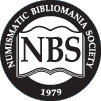 Gary Beals of Segovia, Spain writes:
Gary Beals of Segovia, Spain writes:
Will there be an event for NBS members attending the Long Beach show 4-6 February 2016? I will be going to that show, then be down in San Diego for a month. It would be fun to meet some people face to face there too.
Len Augsburger and I will hold a meeting at the fall Whitman Baltimore show, where we'll give an update on the Newman Numismatic Portal project (Friday, November 6th at Noon). As for Long Beach, who else is interested in a meetup? What about other regional shows in the coming year? These meetups don't have to be associated with a show; if anyone in San Diego would like to meet with Gary during his visit, let me know and I'll put you in touch. My email address is whomren@gmail.com. Thanks. -Editor
SKLOW MAIL BID SALE #26 CATALOG AVAILABLE
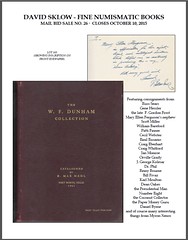 Catalogs for our Numismatic Literature Sale # 26 Closing October 10, 2015 have been shipped and should be in your hands! The catalog is
also available for viewing and downloading at our web site.
Catalogs for our Numismatic Literature Sale # 26 Closing October 10, 2015 have been shipped and should be in your hands! The catalog is
also available for viewing and downloading at our web site.
The sale offers a vast variety of numismatic literature across the entire spectrum of the hobby. There are one thousand, one hundred and twelve lots for you to choose from, enjoy!
David Sklow-Fine Numismatic Books
P.O. Box 6321
Colorado Springs, CO 80934
PH: 719-302-5686
FAX: 719-302-4933
Email: numismaticbooks@aol.com
Web Site: FineNumismaticBooks.com
To read the earlier E-Sylum article, see: SKLOW MAIL BID SALE #26 CLOSES OCTOBER 10, 2015 (www.coinbooks.org/esylum_v18n32a04.html)
NEW BOOK: A GUIDE BOOK OF BARBER SILVER COINS
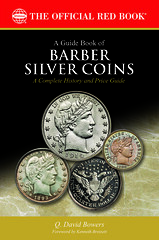 Whitman Publishing announces the release of A Guide Book of Barber Silver Coins, by Q. David Bowers. The 384-page book (number 20 in
the popular Bowers Series) will be available September 22, 2015, from booksellers and hobby shops nationwide, and online (including at
www.Whitman.com), for $29.95. It can also be borrowed for free as a benefit of membership in the American Numismatic Association, through the Dwight
N. Manley Numismatic Library.
Whitman Publishing announces the release of A Guide Book of Barber Silver Coins, by Q. David Bowers. The 384-page book (number 20 in
the popular Bowers Series) will be available September 22, 2015, from booksellers and hobby shops nationwide, and online (including at
www.Whitman.com), for $29.95. It can also be borrowed for free as a benefit of membership in the American Numismatic Association, through the Dwight
N. Manley Numismatic Library.
Barber dimes, quarters, and half dollars were America’s workhorse coins of the late 1800s and early 1900s. While U.S. Mint chief engraver Charles Barber’s designs were at first criticized by the public, today his silver coins are among the most popular U.S. series, with many enthusiastic collectors and students. The Barber Coin Collectors Society is among the hobby’s fastest-growing specialty groups.
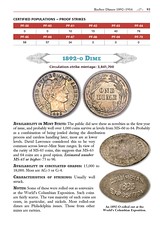 These handsome silver coins were produced from 1892 into 1916, shortly before America entered the First World War, and they remained in
circulation until well after World War II. In the Guide Book of Barber Silver Coins they are given the famous Q. David Bowers treatment: insightful
study by date and mintmark for every issue of the three denominations (277 major varieties), rich historical background, and detailed data analysis.
The text is illustrated by more than 800 images. Bowers—the “Dean of American Numismatics” and the most prolific numismatic author of all time—tells
collectors how to evaluate quality, determine value, understand the market, and make good buys, and takes the reader on a journey through what he
calls “the most interesting and evolutionary period in American history.”
These handsome silver coins were produced from 1892 into 1916, shortly before America entered the First World War, and they remained in
circulation until well after World War II. In the Guide Book of Barber Silver Coins they are given the famous Q. David Bowers treatment: insightful
study by date and mintmark for every issue of the three denominations (277 major varieties), rich historical background, and detailed data analysis.
The text is illustrated by more than 800 images. Bowers—the “Dean of American Numismatics” and the most prolific numismatic author of all time—tells
collectors how to evaluate quality, determine value, understand the market, and make good buys, and takes the reader on a journey through what he
calls “the most interesting and evolutionary period in American history.”
Bowers provides a wealth of information including mintages, certified populations, date-by-date estimates of the total number of pieces existing for both circulated and Proof issues, illustrated grading standards, values in up to 12 grades, and keys to collecting based on availability and sharpness of strike. Historical background details the landscape of American life from the Gilded Age through the Progressive Era, the time of the coins’ design and production.
 The Guide Book of Barber Silver Coins includes a history of U.S. Mint engraver Charles Barber’s life; the mints, Mint directors, and Mint
superintendents responsible for Barber coinage; the public’s evolving attitudes toward his designs; and Barber silver collecting, along with
strategies for building a significant collection of your own.
The Guide Book of Barber Silver Coins includes a history of U.S. Mint engraver Charles Barber’s life; the mints, Mint directors, and Mint
superintendents responsible for Barber coinage; the public’s evolving attitudes toward his designs; and Barber silver collecting, along with
strategies for building a significant collection of your own.
Senior editor of the Guide Book of United States Coins, Kenneth Bressett, calls the book, “a fresh landmark account of Barber coinage touching on every aspect of availability, condition, varieties, history, and collectibility of these fascinating coins.”
A Guide Book of Barber Silver Coins
By Q. David Bowers; foreword by Kenneth Bressett
ISBN 079484315-8 · 6 x 9 inches, softcover, 384 pages, full color ·
Retail $29.95 U.S.
For more information, or to order, see:
Guide Book of Barber
Silver Coins, 1st Edition (www.whitman.com/store/Inventory/Detail/Guide-Book-of-Barber-Silver-Coins-1st-Edition+0794843158)
NEW BOOK: U.S. PAPER MONEY ERRORS, 4TH ED.
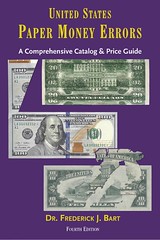 Fred Bart, United States Paper Money Errors, 4th edition, Coin & Currency Institute, Williston, Vermont, 2015, 296 pages,
illustrated, 5.75 x 9 inches. ISBN 978-0-87184-250-3. $27.95.
Fred Bart, United States Paper Money Errors, 4th edition, Coin & Currency Institute, Williston, Vermont, 2015, 296 pages,
illustrated, 5.75 x 9 inches. ISBN 978-0-87184-250-3. $27.95.
After a lapse of seven years, a new, fourth edition of United States Paper Money Errors, Fred Bart’s ground-breaking book is now available. The 4th edition is more than just an update to the third recent – Bureau of Engraving and Printing (BEP) errors have been added, nearly all the illustrations have been changed, there is a rarity guide for each note, which additionally are now priced in four grades (EF, AU, Choice CU and Gem CU), and for the first time, there is a section showing some notes in color.
This has always been an enormously popular book, not only among established collectors, but also with newcomers seeking to learn more about their “find.” There is no other book like it on the market. More than a price guide, its 296 5.75 x 9 inch pages contain a wealth of information on what to look for, as well as the mistakes to avoid. It is a necessity for all dealers, collectors, and anyone who comes into regular contact with paper money.
 Error notes continue to carve an ever larger niche in paper money collecting. This edition of the definitive reference allows advanced
collectors to recognize the value in their holdings and still permits members of the general public to identify potentially profitable notes
encountered in circulation. The book offers more than 550 photos, making identification easy. Chapters are arranged according to the actual
production sequence within the BEP providing a logical flow to the arrangement. The book begins with an overview of paper money production and a
discussion of error collecting. The next section deals with first and second printing errors such as board breaks, double denominations, inverted
backs, and missing and offset printings. The next section details the types of overprint errors including misaligned and missing overprints,
mismatched serial numbers, and stuck digits. The last section is devoted to folds and other errors. In addition, historic photographs from the BEP
offer a fascinating glimpse into currency production during a bygone era, contrasting sharply with the advanced technology in use today.
Error notes continue to carve an ever larger niche in paper money collecting. This edition of the definitive reference allows advanced
collectors to recognize the value in their holdings and still permits members of the general public to identify potentially profitable notes
encountered in circulation. The book offers more than 550 photos, making identification easy. Chapters are arranged according to the actual
production sequence within the BEP providing a logical flow to the arrangement. The book begins with an overview of paper money production and a
discussion of error collecting. The next section deals with first and second printing errors such as board breaks, double denominations, inverted
backs, and missing and offset printings. The next section details the types of overprint errors including misaligned and missing overprints,
mismatched serial numbers, and stuck digits. The last section is devoted to folds and other errors. In addition, historic photographs from the BEP
offer a fascinating glimpse into currency production during a bygone era, contrasting sharply with the advanced technology in use today.
The print version of the book, ISBN 978-0-87184-250-3, has a list price of $27.95 and is available from dealers and wherever numismatic books are sold. It may also be ordered direct from the publisher, Coin & Currency Institute, P.O. Box 399, Williston, Vermont 05495.
An E-book edition, ISBN 978-0-87184-005-9, is available for digital download on the website of the publisher, on USB stick, or from the Amazon Kindle store. List price is $17.50
For more information, or to order, see:
The 4th edition of United States Paper Money Errors
(www.coin-currency.com/page253.html)
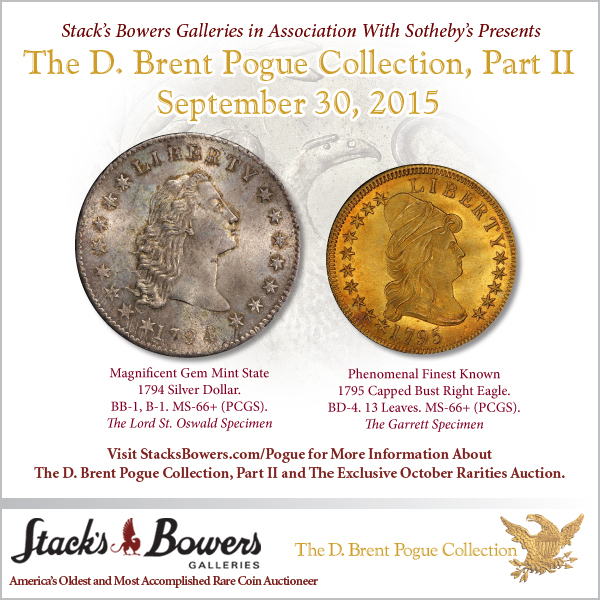
NEW BOOK: AMERICAN JOURNAL OF NUMISMATICS 26 (2014)
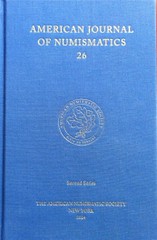 American Journal of Numismatics 26 (2014)
American Journal of Numismatics 26 (2014)
Hardback, illus.,386 pp., 62 plates
ISSN 1053-8356
ISBN 10:0-89722-336-5
ISBN 13:978-0-89722-336-2.
Andrew R. Meadows, Editor
Oliver D. Hoover, Managing Editor
Editorial Committee
Jonathan Kagan. Notes on the Coinage of Mende
Evangeline Markou, Andreas Charalambous and Vasiliki Kassianidou. pXRF Analysis of Cypriot Gold Coins of the Classical Period
Panagiotis P. Iossif. The Last Seleucids in Phoenicia: Juggling Civic and Royal Identity
Elizabeth Wolfram Thill. The Emperor in Action: Group Scenes in Trajanic Coins and Monumental Reliefs
Florian Haymann The Hadrianic Silver Coinage of Aegeae (Cilicia)
Jack Nurpetlian. Damascene Tetradrachms of Caracalla
Dario Calomino. Bilingual Coins of Severus Alexander in the Eastern Provinces
Saúl Roll-Vélez. The Pre-reform CONCORDIA MILITVM Antoniniani of Maximianus: Their Problematic Attribution and Their Role in Diocletian’s Reform of the Coinage
Daniela Williams. Digging in the Archives: A Late Roman Coin Assemblage from the Synagogue at Ancient Ostia (Italy)
François de Callataÿ. How Poor are Current Bibliometrics in the Humanities? Numismatic Literature as a Case Study
Michael Fedorov. Early Mediaeval Chachian Coins with Trident-Shaped Tamghas, and Some Others
Antonino Crisà. An Eighteenth-Century Sicilian Coin Hoard from the Termini-Cerda Railway Construction Site (Palermo, 1869)
Review Articles
From the blog post:
The review articles by ANS curators Gilles Bransbourg and David Hendin focus on Le monnayage de Maxence (2013) by Vincent Drost and Gold Coin and Small Change: Monetary Circulation in Fifth– Seventh Century Byzantine Palestine (2012) by Gabriela Bijocsky.
Again, the AJN 26 is available to order on the website, or you can call Catherine DiTuri to place your order at 212-571-4470, ext. 117. The list price is $75; ANS members may purchase it for $52.50.
For more information, or to order, see:
American Journal of Numismatics 26 (2014) (http://numismatics.org/Store/AJN26)
NEW BOOK: NUMISMATIC ARCHAEOLOGY OF NORTH AMERICA
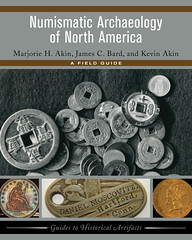 Numismatic Archaeology of North America
Numismatic Archaeology of North America
A Field Guide
Marjorie H Akin (Author); James C Bard (Author); Kevin Akin (Author)
350 pp. / 8.00 x 10.00 / Dec, 2015
Paperback (978-1-61132-920-9)
Hardback (978-1-61132-919-3)
eBook (978-1-61132-922-3)
Available Dec, 2015
Numismatic Archaeology of North America is the first book to provide an archaeological overview of the coins and tokens found in a wide range of North American archaeological sites. It begins with a comprehensive and well-illustrated review of the various coins and tokens that circulated in North America with descriptions of the uses for, and human behavior associated with, each type.
The book contains practical sections on standardized nomenclature, photographing, cleaning, and curating coins, and discusses the impacts of looting and of working with collectors. This is an important tool for archaeologists working with coins. For numismatists and collectors, it explains the importance of archaeological context for complete analysis.
For more information, or to order, see:
Numismatic Archaeology of North America A Field Guide
(www.lcoastpress.com/book.php?id=517)
To read the earlier E-Sylum articles, see:
NEW BOOK: THE COINS OF FORT ATKINSON (www.coinbooks.org/esylum_v18n10a04.html)
BOOK REVIEW: THE COINS OF FORT ATKINSON
(www.coinbooks.org/esylum_v18n20a06.html)
BOOK REVIEW: WHITMAN ENCYCLOPEDIA OF MEXICAN MONEY
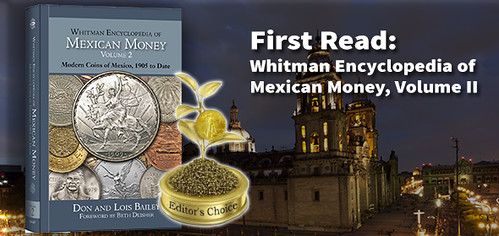
In 2014, Whitman published the Whitman Encyclopedia of Mexican Money, Volume 1: An Illustrated History of Mexican Coins and Currency by Don and Lois Bailey.
For the Baileys, lifelong ambassadors for the rich numismatic legacy of Mexico, it was an ambitious undertaking.
Possibly too ambitious.
It’s not that the authors lacked the vision or the knowledge to bring a comprehensive reference on Mexican coinage to fruition… Don Bailey’s legacy as an expert in the field has been in public view for more than 50 years. His published work has helped popularize Mexican numismatics in the United States.
A former contributor to World Coin News, Coin World, and a number of standard references, and a founding member of the United States Mexican Numismatic Association (and editor of its journal), Don Bailey has been the go-to-guy for collectors looking to expand their horizons into the turbulent and fascinating coins of our neighbor to the south. Former Coin World editor Beth Deisher credits Bailey for helping her publication make inroads with the Mexican Mint.
But Whitman’s Volume 1 feels rushed and overly technical, as if it were trying to do too much too fast and in too small a space.
This is to be expected, however–is it really possible to cover 500 years of Mexican coinage in 490 pages without giving something the short shrift?
Volume 1 also didn’t exemplify the Whitman layout philosophy that we’ve seen come into bloom in recent years. Coin images are sequestered “plate style”, and coin descriptions are provided in numismatic shorthand.
We bring this up not to be overly critical of the effort–which was undoubtedly immense–but to the beginning and intermediate collector that Whitman traditionally caters to, Volume 1 may seem like a joyless affair.
For Volume 2, Whitman radically overhauled everything. Two comes across as more of a reboot than a continuation of the conversation. Which is odd, but at the same time very much welcome.
Starting with the Coinage Reform of 1905 (which saw the production of Mexican coins come under federal control), and continuing through to the Coinage Reform of 1992 (which saw the introduction of the new peso), Volume 2 reads like a long-tenured and trusted roadmap for collectors of the series.
Also included in Volume 2 is a comprehensive guide to 20th- and 21st-century Mexican commemorative coinage, the popular Mexican Libertad bullion coin program, and Mexico’s Pre-Columbian commemorative bullion series.
It’s essentially a Bowers Series book about numismatics, which should come as welcome news to most collectors who might be considering a purchase.
To be honest, this tried-and-true formula is what Whitman does best, and in spending a weekend with Volume 2 it’s hard to contemplate that this well-fleshed-out and necessary reference is only now coming to print.
In Whitman’s press materials, the publisher claims that “future volumes … will focus on media of exchange from pre-Columbus days through the colonial period and Republican decimal coinage … and the coins and tokens of the 1910-1920 Mexican Revolution”. And while we don’t know how these future volumes will turn out, we think it’s safe to say that no reference written for the English-speaking market will have a greater impact on bringing new collectors to Mexican coins than the Whitman Encyclopedia of Mexican Money, Volume 2: Modern Coins of Mexico, 1905 to Date.
This is an exceptional book that belongs on the shelf of every collector and therefore we give it CoinWeek’s Editor’s Choice Award.
Whitman Encyclopedia of Mexican Money, Volume 2: Modern Coins of Mexico, 1905 to Date By Don and Lois Bailey; Diana Plattner, Research Editor Whitman Publishing, LLC, 2015. 474 pages.
To read the complete article, see:
First
Read: Whitman Encyclopedia of Mexican Money, Volume 2: Modern Coins of Mexico, 1905 to Date
(www.coinweek.com/featured-news/first-read-whitman-encyclopedia-mexican-money-volume-2-modern-coins-mexico-1905-date/)
NNP LOCATES NEEDED COUNTERFEITING REPORT VOLUME
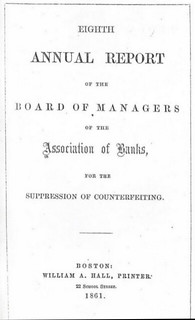 Reader Loren Gatch wrote to Len:
Reader Loren Gatch wrote to Len:
Attached is a scan of my copy of this volume. I do apologize for its lack of alignment, etc., as well as for the check marks next to the banks' names on the final pages. Those weren't on the original, but were my doing.
While scanning it, I noticed the unusual call number, which reminds me that I most likely made this copy at the Mudd Library at Yale. So if posterity deserves a better copy than mine, the original can be found there!
Len writes:
The turnaround time of this whole thing is remarkable. We've gone from "missing document" to crowdsourcing to "publicly and permanently available" in three days.
 To read the complete publication, see:
To read the complete publication, see:
Eighth Annual Report of the Board
of Managers of the Association of Banks, for the Suppression of Counterfeiting (https://archive.org/details/EighthAnnualReportOf
TheBoardOfManagersOfTheAssociationOfBanksFor)
To browse the growing collection of publications digitized to date, see:
Newman Numismatic Portal (https://archive.org/details/newmannumismatic)
To read the earlier E-Sylum article, see:
NNP SEEKS MISSING COUNTERFEITING REPORT VOLUME
(www.coinbooks.org/esylum_v18n34a08.html)
THE BOOK BAZARRE
ROBERT RHUE REMEMBERS ROBERT VLACK
Although I hadn't seen Bob for the last few years I have one particularly fond memory.
Back in the mid-80s I stopped by his table at a New York show. Among many other things in stock he had separate notebooka full of colonial notes – a separate one for each state as well as another one for Continental currency.
I became particularly attracted to the notebook of Georgia notes from 1776 through 1778, specifically because of their vignettes/seals of various vivid colors.
So I immediately jumped on the opportunity to purchase a handful and begin a collection.
Of the 50 different types and denominations of the colored seal series, I accumulated 48 of them over the next 10 years, with about half of them initially coming from Bob, albeit a number of those I upgraded over time.
To this day my collection of Georgia colonials is one of my favorites, and I have exhibited it competitively at ANA shows two or three times.
I have Bob to thank for sharing his expertise, and mentoring me in my pursuit. By his nature he seemed always willing to share his vast knowledge, and in a friendly yet businesslike manner
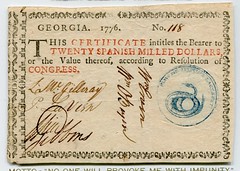
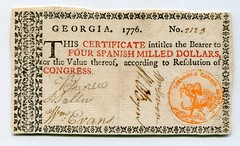
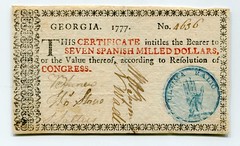
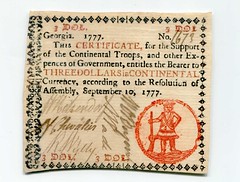
To read the earlier E-Sylum article, see:
ROBERT A. VLACK, 1927 - 2015 (www.coinbooks.org/esylum_v18n33a05.html)
NOTES FROM E-SYLUM READERS: AUGUST 30, 2015
Query: 1783 1000 Mill Pattern Dollar Pedigree
Gene Anderson writes:
Volume II, Number 1 of The Asylum (Spring 1982) included an article by Robert I. Wester on S.S. Crosby’s family. In that article, he makes the following statement: “Of all the coins in Sylvester’s cabinet he perhaps prized most the 1783 1000 Mill Pattern Dollar which appears, embossed in gilt, on the cover of the morocco-bound presentation advance copy of The Early Coins of America.” Dave Bowers had an article in the March 2015 issue of The Numismatist. This early U.S. pattern coinage in which he traces the provenance of the unique pattern mark (1,000 units piece). Crosby is not brought up.
Chess-Playing American Numismatist: Carl Rosenblum
Bill Rosenblum writes:
My Dad, Carl Rosenblum, was both a numismatist and a chess-player (and chess teacher). For about 20 to 25 years Dad ran W. P. Andrews Co., Inc. First based in West Orange, NJ and later Southbury, CT the company specialized In Israeli numismatics as well as US coins. He set up under W.P. Andrews at many (now defunct) NYC shows as well as other shows in the Garden State and had a world-wide mail order business for Israeli coins. He also was an avid chess player although I have no idea what his ranking was.
When he moved to Southbury in the late 1980s he began to volunteer to teach chess to grade school students throughout the Southbury area. He continued to do this until he was 94 or so when the spirit was still willing but driving the roads of rural Connecticut was too much for him. But he continued to love chess.
I spoke to him on the phone the day before he passed away. He was in a Waterbury, CT hospital and I was unable to leave snow-bound Colorado to see him. I asked him how he was feeling and he said "fine" (He always said fine) but he was bored, "there was nobody to play chess with".
To read the earlier E-Sylum articles, see:
QUERY: CHESS-PLAYING AMERICAN NUMISMATISTS SOUGHT
(www.coinbooks.org/esylum_v18n32a14.html)
NOTES FROM E-SYLUM READERS: AUGUST 16, 2015 : More Chess-Playing American
Numismatists (www.coinbooks.org/esylum_v18n33a08.html)
NOTES FROM E-SYLUM READERS: AUGUST 23, 2015 : Steve Ruddell, Chess Player
(www.coinbooks.org/esylum_v18n34a11.html)
Free Shipping For Six-Figure Coins
Chip Howell writes:
Did you know they sell coins on Amazon? I never even bothered to look, but here's an item that may prove irresistible...
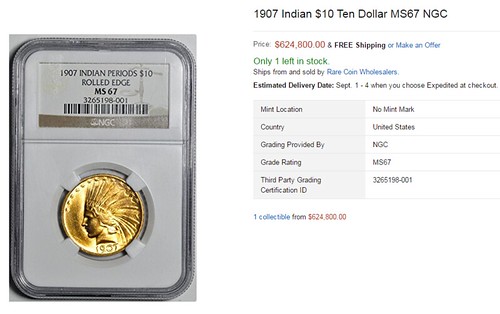
Chip adds:
I mean, free shipping? How can you NOT buy it?
To view the item on Amazon, see:
1907 Indian $10 Ten Dollar MS67 NGC (www.amazon.com/gp/product/B00SS17TZM)

MORE ON WILLIAM WEEKS
I want to comment on the post on William Weeks. It was stated that he was pictured in the photo of the January 24, 1913 New York Numismatic Club dinner. I was curious what he looked like, so I pulled my 1913 yearbook of the NYNC off the shelf. It is a nice clear photo. Among others, Mr. and Mrs. Henry Chapman are right in the center of the first row. Mrs. Chapman was a very nice looking lady.
However, Wm Weeks is not listed as one of the attendees. Also there is a list of the 1913 members of the NYNC, and Weeks is not listed as a member.
I also checked the McKay catalog of book sales, and found three sales of the Weeks library by Stan V. Henkels & Co. all in 1902:
February 20: Autograph letters and historical documents.
March 5: Americana
March 10: Miscellaneous books.
Numismatic books are not mentioned. There is a picture of William Weeks in the book The American Numismatic Society 1858-1958 opposite page 116.
Bilimbiques Slang for the promissory notes used during the Mexican Revolution of 1910-1917. The word is said to have originated from the Mexicans’ pronouncing the name William Weeks, an America cashier at a mine in Mexico some years before the revolution. He issued promissory notes to the miners that were called “William-Weeks” but over the years the word bilimbique evolved and was applied to any promissory note of the time.
Gary adds:
Any of the Mexican revolution bills 1910-1917 fall under this term — as best I know. Dozens of types and denominations. Many printed by American Banknote Co. -- beautiful. Many were also used as Movie Money.
And speaking of Mexico, I am looking for Clyde Hubbard, noted author on Mexico coins.
To read the earlier E-Sylum article, see:
WILLIAM WEEKS AND HIS 1839 LARGE CENTS
(www.coinbooks.org/esylum_v18n34a16.html)
MONROE F. WALTERS
Walters, Monroe F. (1867-1948), was born on November 3,1867, son of Monroe and Isabella Walters. He only attended school up to the 8th grade. He lived at Goshen Bridge, Virginia, then at Low Moor, Virginia, and later Clifton Virginia. He later on returned to Ohio and resided at 1358 North 5th Street Columbus, Ohio.
He was originally from Logan, Ohio, where he worked as a sales clerk in the coal mining industry for the Columbus and Hocking Coal and Iron Company (C & H. C & I. Co.) store, and later on at their plant in Longstreth, Ohio. On November 14, 1887 he married Lillie "Lillian" M. Turner, at Gallia, Ohio. They had a son Louis Walters (1892-). He and his family moved to Goshen, Virginia on February 2, 1889, where he worked as a sales clerk in the Victoria Furnace store. His name appeared in the March 1892 issue of The Numismatist, in list no. 15, as number 442.
By 1893 he worked for the Virginia Iron & Railway Company at Goshen Bridge.
He was a correspondent with the Chapman Brothers and placed bids in their auctions. The Lupia Numismatic Library contains various letters from him to the Chapman Brothers about coin auction sales.
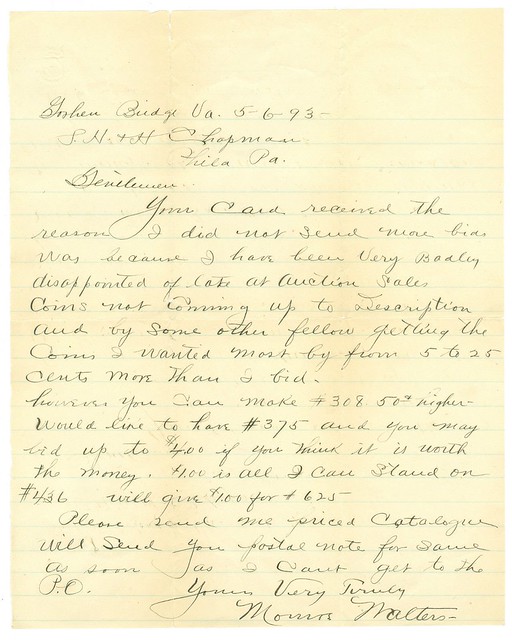
Letter dated May 6, 1893 from Monroe F. Walters to the Chapman Brothers complaining about coin descriptions regarding condition or grading in coin auction catalogues not being true to objective eyes. A familiar complaint found among collectors and dealers reminiscent of the famous Cogan and Mason feud of 1868 to 1869 (q.v. sub Cogan). A second complaint about auction sales was losing a lot and becoming the under bidder by a fractional dollar amount such as a mere nickel. That is something frustrating indeed!
The remainder of the letter are discussions about four lots and his bids for the Chapman coin auction consigned by Nicholas Petry, to be sold May 10, 1893, just 4 days from the date of the letter. Courtesy the Lupia Numismatic Library, Special Collection, The Chapman Family Archive.
He sold his coin collection of 451 lots containing fine Canadian coins, medals, jetons, U. S. coins, Colonial coins and numismatic literature and coin auction catalogues through Ed Frossard’s 127th Sale, on September 27, 1894. He remained an active numismatist his entire life.
According to the 1900 U. S. Census, he and his wife had a boarder, Thomas W. Merry a superintendent of ore mines.
His membership in the ANA lapsed and he rejoined in 1906 and was assigned member No. 812.
In the 1930 U.S. Census he and his wife Lillian and their son Louis were living in Columbus, Ohio, where he worked as a janitor at Ohio State University since 1928 with an annual salary of $1,380.00. In the 1940 U. S. Census he worked as a supply man at Ohio State University.
On May 10, 1943, at the 137th monthly meeting of the Columbus Numismatic Society he exhibited National Bank Notes of the First Charter Period.
He died on October 27, 1948 one week before his 81st birthday and is buried in the New Lexington Cemetery, Perry County, Ohio.
To read the complete article, see:
WALTERS, MONROE
F. (https://sites.google.com/site/numismaticmallcom/encyclopedic-dictionary-of-numismatic-biographies/walters-monroe)
QUERY: BRASS CASTORLAND MEDAL INFORMATION SOUGHT
Chester Sullivan writes:
I'd like to thank David Gladfelter for writing the informative article on William Anton, and thanks to Wayne for publishing it. I wrote several letters to William Anton seeking information about the brass Castorland he advertised in the Feb. '05 Numismatist..."$245,000.00 gem proof ex J. H. U." All my letters were returned by USPS as undeliverable. I began then asking around and John Bolger generously sent me offprints of the Bowers & Ruddy Oct. 1-2, 1980 sale of the Garrett Collection that listed it as: "Unique Brass 'Original" Castorland Medal. choice uncirculated, from Mills Collection.", where it sold for $5,750.00. I continued inquiring and when I mentioned it to Jeff Rock he wrote me, "Incidentally, I was offered the piece by Anton for $25,000.00 around 1990. I passed on it then, even though I thought it was quite cool, but at the time that would have bought me a pair of silvers and a copper original!"
So I'm still seeking information on this brass specimen. Maybe Anton sold it long ago. Thanks again for your article, and thanks to John Bolger and Jeff Rock.
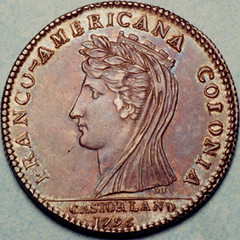
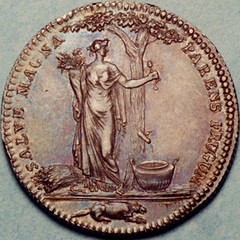
In the February 2005 issue of NUMISMATIST (page 63), William Anton offered a 1796 Brass Castorland Half Dollar for $245,000.00, describing it as follows: "Unique, struck in brass and probably the finest Castorland struck. Gem Proof. Ex. J.H.U."
PCGS MS-64. Ex - Paul Arthur Norris (purchased privately) - Ira & Larry Goldberg Coins & Collectibles, Inc.'s "Pre-Long Beach Sale", September 23 & 24, 2002, Lot 89, illustrated, where it was described as follows: "Original unbroken die. PCGS graded MS-64. A rare original example of this medal, that approaches gem! The surfaces display a delicate pinkish hue over silvery gray tones atop the mirror fields. Boldly struck on both sides, without any signs of weakness on the high points of the devices. These were struck at the Paris Mint, and were made to circulate in the new French colony being formed in upper New York, along the Beaver River. As the political climate changed dramatically with the French Revolution in 1792, those who had been in power or sympathetic to the Royals feared for their safety. The Reign of Terror began, and many aristocrats were hung or jailed. Those that could moved away, and some signed on to move to the new French American colony.
The legend FRANCO AMERICANA COLONIA translates to "French American Colony", with the central head device that depicts a women with a veil, and an unusual crown which appears like the crenelated tower from a castle. The French word "Castor", translates to "beaver", hence the colony became known as Castorland. Hence, the beaver motif on the bottom of the reverse, with the maple tree above, next to which stands the Goddess Ceres, patroness of agriculture, with a drill in one hand (to free the maple sap from the tree), and the open tap in the tree below, with the sap flowing freely, and a cornucopia in the other hand symbolizing the hoped for success in agriculture from the new colony. The Latin motto SALVE MAGNA PARENS FRUGUM, means "Hail, great mother of crops" (Breen), and is from Virgil's Georgics.
Epidemics and severe winters plagued those hearty souls in the first years of the new colony, and in short order most of the original inhabitants of Beavertown had either died or moved away, and within a few more years nothing remained of the colony except the original name. Most of the coins that arrived with the colonists were well circulated during these times, and few are found in mint condition, as we see here.
David Gladfelter adds:
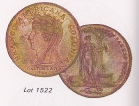 Here is a color image of Anton’s brass coin from the Garrett III catalog (it’s lot 1522 and it’s one of those tiddlywinked images as you
see). Garrett had four so-called “original” Castorlands (lots 1519-1522, all plated in the catalog) and one so-called “restrike” from original dies
(lot 1523, not plated).
Here is a color image of Anton’s brass coin from the Garrett III catalog (it’s lot 1522 and it’s one of those tiddlywinked images as you
see). Garrett had four so-called “original” Castorlands (lots 1519-1522, all plated in the catalog) and one so-called “restrike” from original dies
(lot 1523, not plated).
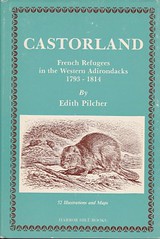 Readers may be aware of some fairly recent scholarship on the Castorland settlement: Edith Pilcher, Castorland: French Refugees in the
Western Adirondacks, 1793-1814 (Harrison, N.Y., Harbor Hill Books, 1985), and Angel Pietri, “The History of the Castorland Settlement,” The C4
Newsletter vol. 5 #1 pp. 15-29 (Spring 1997).
Readers may be aware of some fairly recent scholarship on the Castorland settlement: Edith Pilcher, Castorland: French Refugees in the
Western Adirondacks, 1793-1814 (Harrison, N.Y., Harbor Hill Books, 1985), and Angel Pietri, “The History of the Castorland Settlement,” The C4
Newsletter vol. 5 #1 pp. 15-29 (Spring 1997).
Both of these references are listed by Q. David Bowers in the bibliography of his 2009 book, Whitman Encyclopedia of Colonial and Early American Coins. Edith Pilcher is a freelance writer specializing in Adirondack and travel topics; her publisher specializes in the local history of New York State. Angel O. Pietri, M.D., was president of the Colonial Coin Collectors Club from 1994 to 1996, and was motivated to dig into Castorland history after bidding on Louis Eliasberg’s specimen of the Castorland medal and reading Ms. Pilcher’s book.
To read CoinFacts article, see:
Castorland Jetons
(www.coinfacts.com/colonial_coins/castorland/castorland_jetons.htm)
To read the earlier E-Sylum articles, see:
MORE ON AUTHOR BILL ANTON, JR. (www.coinbooks.org/esylum_v18n34a18.html)
HELP SOUGHT FOR CENSUS OF CASTORLAND JETONS
(www.coinbooks.org/esylum_v18n16a15.html)
THE BOOK BAZARRE
2015 ANA WORLD’S FAIR OF MONEY EXHIBIT WINNERS
The American Numismatic Association presented 53 competitive exhibit awards at the 2015 World’s Fair of Money in Rosemont, Illinois. Winners were announced at the exhibit awards presentation and reception and the awards banquet on August 14. A total of 36 exhibitors of all ages and experience levels, showing 60 exhibits, competed in this year’s program. There were also six non-competitive exhibitors showing six additional exhibits.
Lawrence Sekulich received the Howland Wood Memorial Award for Best-in-Show for his exhibit “They Flap, Flutter and Float: Various Winged Immortals Appearing on Coins from Ancient to Modern Times.”
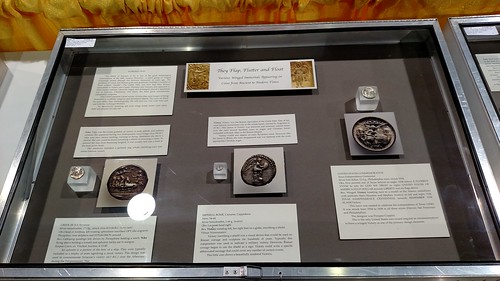
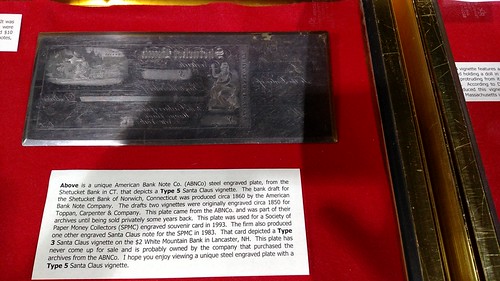
The Radford Stearns Memorial Award for Excellence in Exhibiting, presented to the first and second runners-up, was awarded to Nancy Wilson for “Santa Claus Obsolete Notes & Vignettes,” and to Lawrence Sekulich for “Faces of Gold: A Small Gallery of Coin Portraits from Ancient Greece to 20th Century America.”
Matte Proof Lincoln Cents
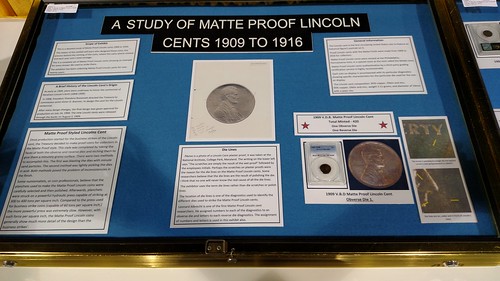
Class 1: United States Coins, Lelan G. Rogers Memorial.
First place: Carl Waltz, Jr. for “A Study of Matte Proof Lincoln Cents 1909 to 1916.”
Tybee Island Lighthouse Note,
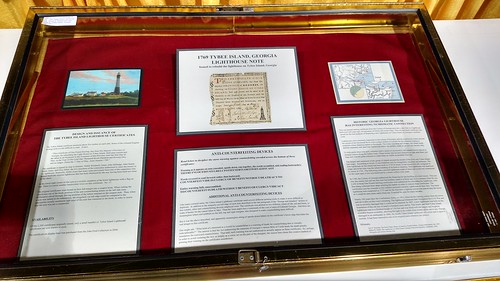
Class 2: United States Fiscal Paper, Sidney W. Smith/William Donlon Memorial.
Third place: Robert Rhue, for “1769 Tybee Island Georgia Lighthouse Note, Issued to Rebuild the Lighthouse on Tybee Island, Georgia.”
The Sower
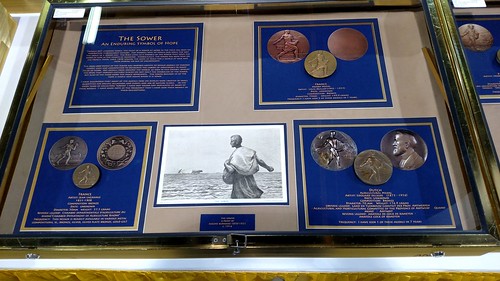
Class 3: Medals, Orders, Decorations and Badges, Burton Saxton/George Bauer Memorial.
First place: Mitch Ernst, for “The Sower, an Enduring Symbol of Hope.”
1876 U.S. Centennial Wooden Medals
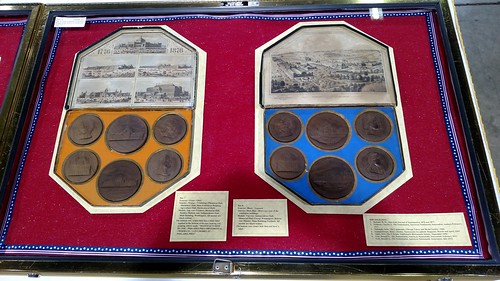
Class 3: Medals, Orders, Decorations and Badges, Burton Saxton/George Bauer Memorial.
Second place: Darrell E. Luedtke, for “A Complete Collection of Wooden Medals of the 1876 U.S. Centennial.”
The Ba’al Shem Tov Amulet
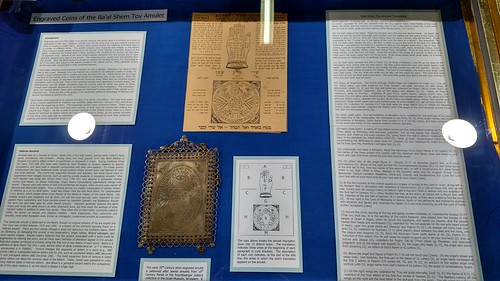
Class 7: Engraved Coins, Love Token Society Award.
First place: Simcha Laib Kuritzky, for “Engraved Coins of the Ba’al Shem Tov Amulet.”
Numismatic literature Exhibit Winners
First place: Mark Wieclaw, for “‘Roman Coins and Their Values’: The Evolution of the Most Used Reference on Ancient Roman Coinage.
Second place: Carl Waltz, Jr., for “Publications by Charles T. Steigerwalt.”
Third place: Scott A. McGowan, for “Buy the Book before the Coin.”
To read the earlier E-Sylum article, see:
2015 ANA SHOW NUMISMATIC LITERATURE EXHIBITS
(www.coinbooks.org/esylum_v18n34a13.html)
AN 1808 CONTEMPORARY COUNTERFEIT 2 REALES
First off, I would like to thank all the folks who stopped by my table at the ANA to say that they enjoyed reading these emails. After confirming that they weren't confusing my newsletter with someone else's, I told each that I was grateful for their kind words. It's nice to know that there are at least a few people in Internet Land that appreciate this mix of semi-interesting numismatic tidbits and offerings of fresh-to-market coins. But just when I was getting a swelled head and started to ponder a 2nd career as a highly compensated e-newsletter writer, I received a text from a close friend in the coin business who has quite a different opinion:
“Just my personal observation is that your (newsletter) seems to get clogged up with some verbose minutia. If that appeals to a lot of people then you should keep it up, but I'm just giving you my personal take (maybe that also delays getting out your list?) “
He's absolutely right, of course. Between getting all of the new coins home from the show and photographed, then describing them, then performing my regularly scheduled procrastination duties, then finally getting to writing all of the verbose minutia and sending it out, I'm positive it could be out the door much sooner. But since I can't fire myself, and since these are still a lot of fun for me to write, I'll keep on plodding away as before.
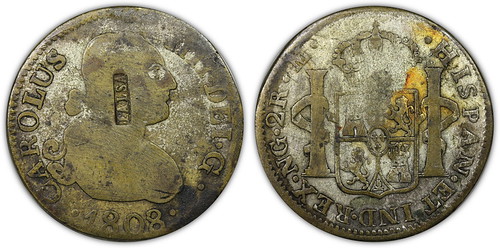
1808 Contemporary Counterfeit 2 reales. Very Fine [uncertified]. Unlisted in the Kleeberg study, but it has since been given Kleeberg #08D-G4. This is the plate coin to John Lorenzo’s update to the Kleeberg study on these pieces, and still unique. While being unique is cool, that is not even the coolest part of this piece. At one point it must have circulated among a Spanish speaking population, and after discovery as a counterfeit it was stamped “FALSA”. Even after it was stamped, it appears that it circulated for some time after that. Well made, with abundant silvering still remaining. This coin would be a highlight of any collection of contemporary counterfeits. $785.
"It's a counterfeit."
"So we can't slab it?"
"Sure we can slab it - it's a contemporary counterfeit"
"So it's a genuine fake?"
"Something like that."
"But the counterstamp says 'FALSA' - doesn't that mean it's really, really fake?"
"Well, it's a genuine fake counterstamp"
"But Who's on First?"
"Very funny. Actually, a genuine coin came first. Then somebody made a fake of it. But not last week, last century. So it's a contemporary counterfeit, and that's considered genuine. Along the way somebody stamped it FALSA. But it's a FALSA genuine 2 reale, not a FALSA genuine fake. It's a real fake."
"Really?"
"Really."
"I'm not typing up that label."
-Editor
To read Dave's complete newsletter, see:
Making the Grade #22: A Fair to Remember (www.davewcoins.com/newsletter)

THE SAINT-GAUDENS CORNISH MASQUE PLAQUETTE
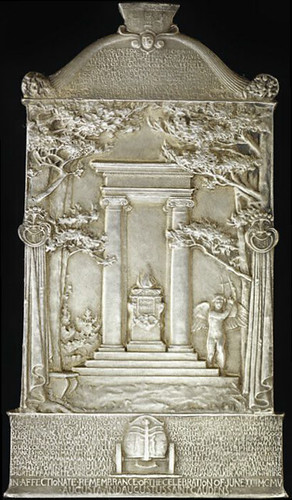 Walk into any American coin show, ask for a “Saint,” and nearly everyone in the room will know exactly what you mean. Nicknamed for its
designer, Augustus Saint- Gaudens, these $20 gold pieces (double eagles) represent the pinnacle of American numismatic artistry as produced for
circulation. While he designed other coins, such as the $10 Indian Head (eagle), struck for more than two decades, some, like his Liberty Head cent,
never came to fruition.
Walk into any American coin show, ask for a “Saint,” and nearly everyone in the room will know exactly what you mean. Nicknamed for its
designer, Augustus Saint- Gaudens, these $20 gold pieces (double eagles) represent the pinnacle of American numismatic artistry as produced for
circulation. While he designed other coins, such as the $10 Indian Head (eagle), struck for more than two decades, some, like his Liberty Head cent,
never came to fruition.
Also found in “Gus” Saint-Gaudens’ portfolio of small works are a few medals produced either in miniscule numbers for friends or for monumental events like the 1889 centennial of George Washington’s presidential inauguration, the 1893 World’s Columbian Exposition or Theodore Roosevelt’s 1905 inauguration.
But Saint-Gaudens created one medal that has all but escaped the notice of mainstream American numismatics. Not only was it truly wrought by the great sculptor himself, but he also paid for the entire production and personally distributed examples to his good friends. Incredibly, he did this while his health and his life were slipping away and he was designing what would become our most beautiful circulating coins.
Referred to as the “Cornish Masque plaquette,” the piece is fully understood only by looking beyond numismatics and seeing Saint-Gaudens as a sculptor, teacher and individual.
Fed up with the New York rat race in the mid-1880s, the artist gradually moved his family and studio to an 18th-century estate in Cornish, New Hampshire, which he later purchased and dubbed “Aspet.”
There he could work and enjoy life in the idyllic mountains of New England while escaping the steam and stench of summer in the city. But Gus was not the only person attracted to this bucolic setting: almost immediately, artistic friends of all disciplines and abilities began to arrive in and around Cornish. By the turn of the century, the Saint-Gaudenses, and a few others dubbed “Chick - a dees” (because they, like the small birds, were yearround residents), called the area home.
Unwittingly, Augustus Saint-Gaudens and his wife, Augusta, started a phenomenon now recognized as a landmark in the history of American arts, casually referred to as the Cornish Art Colony. By the time the colony petered out after the First World War, some if its members included famous painters like Maxfield Parrish, Kenyon Cox and Thomas Dewing, along with numismatically familiar sculptors such as Paul Manship, and James Earle Fraser and his wife, Laura Gardin Fraser.
By early 1905, it was apparent that Saint-Gaudens was succumbing to cancer. The members of the colony, realizing they soon would lose their beloved founder, mentor and friend, decided to do something genuinely exceptional to honor him. A special event was held on the evening of June 22, 1905, in the form of a masque, which in this case was a classically themed, highly extravagant outdoor play. The setting was a pine grove at the edge of a wooded bluff down the slope from Aspet. In the forest were members of the Boston Symphony Orchestra, hidden so that their musical accompaniment, arranged by composer Arthur Whiting, would effuse mysteriously from the trees. The white plaster and wood set was a fourcolumned altar, flanked by two more columns and large comic masks.
In front were benches for the audience, all of whom were invited guests and friends. The event was billed as “A Masque of ‘Ours’: The Gods and the Golden Bowl,” and all aspects of its planning were kept secret from the Saint-Gaudens family, who had promised to keep away from that part of the property.
Ninety of the family’s closest friends from the Cornish area formed the imaginatively costumed cast, and there were props galore, some of which survive today.
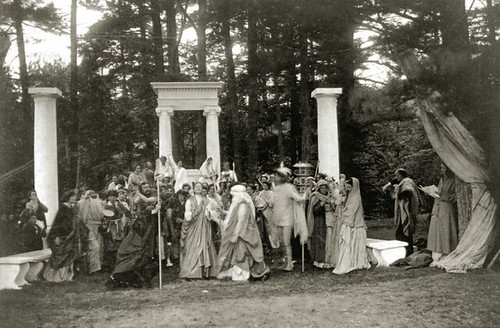
Dress Rehearsal
To the modern American, such an extravagant, classical tribute might seem overblown and silly, but Saint-Gaudens did not take it that way. In fact, it was one of the most meaningful moments of his life.
A production of this magnitude and beauty, all created in Saint-Gaudens’ honor, could not go unacknowledged, and Gus set to work on a “thank you” as only he could have executed it. Through the last months of 1905, the ailing artist struggled to sculpt a bas relief commemorating the Masque, and, in so doing, created one of his most intricately detailed and text-laden works.
The central portion of the design focuses on the scene of the Masque, and shows a temple set in the pine grove. At the sides, comic masks are hung from the trees, which support drawn curtains exposing a lone bench at the left. Below the canopy of the temple is a flaming altar inscribed with “Love Conquers” in Latin. To its right is the winged cherub Amor, playing Apollo’s lyre. The arching panel forming the top of the plaque is framed by a pair of cornucopias and crowned by a depiction of the Golden Bowl given to the Saint-Gaudenses. A rectangular panel below the temple forms the base of the medal, and is punctuated by an image of the chariot in which the couple was transported from the play.
Most remarkably, the top and bottom panels are filled with the fully legible names of all 90 colony members who participated in the Masque!
At the foot of the plaquette, the sculptor included the inscription IN AFFECTIONATE REMEMBRANCE OF THE CELEBRATION OF JUNE XXIII [sic] MCMV—AUGUSTA AND AUGUSTUS SAINTGAUDENS.
For whatever reason, Saint-Gaudens’ recollection of the date was wrong since the Masque took place the day before, on June 22.
By early 1906, the artist’s master for the Masque plaque had been dispatched to Europe and had arrived at the Paris establishment of Janvier et Duval. No other “art reduction” medalists could match the quality that came out of this shop, not even the famed Tiffany & Company and Gorham Manufacturing Company, both of which used the ingenious reducing lathe Janvier had invented. (The lathe operated on a principle similar to a pantograph, copying a coinage design from a large model and engraving the image on a smaller master die.)
When Gus’ son Homer published The Reminiscences of Augustus Saint-Gaudens in 1913, he stated only that his father distributed the plaquettes during the summer of 1906 “to those who shared in the performance.” Apparently, Gus, in his weakened state, handed them out to friends as the opportunity arose, likely when they visited the artist at Aspet.
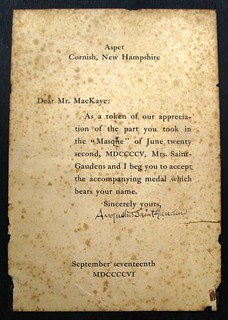 The Masque plaquette illustrated here is the very one Saint-Gaudens presented to Eric Pape, surviving in the frame in which the latter
displayed it. Although Pape was not one of the 90 participants in the Masque, he was close enough to Gus to have received one of the 10 extras
ordered from Paris. Clearly, Pape put his treasured plaquette to good use, as his painting’s resemblance to the composition of the plaquette is
unmistakable. It is marked “BRONZE” on the edge, and is struck with what may be the tiniest maker’s mark I have ever seen. Measuring 1.5mm, it
carries the initials “JD,” for Janvier et Duval, with a downward-pointing dagger between them.
The Masque plaquette illustrated here is the very one Saint-Gaudens presented to Eric Pape, surviving in the frame in which the latter
displayed it. Although Pape was not one of the 90 participants in the Masque, he was close enough to Gus to have received one of the 10 extras
ordered from Paris. Clearly, Pape put his treasured plaquette to good use, as his painting’s resemblance to the composition of the plaquette is
unmistakable. It is marked “BRONZE” on the edge, and is struck with what may be the tiniest maker’s mark I have ever seen. Measuring 1.5mm, it
carries the initials “JD,” for Janvier et Duval, with a downward-pointing dagger between them.
Gus died at home on August 3, 1907, and was cremated shortly thereafter in Boston. Below the house, at the bottom of Aspet’s sloping lawn, stood the decomposing temple created for the Masque. Like many of the ephemeral structures built for the great world’s fairs of the period, it was a temporary structure made of reinforced plaster applied to a wooden frame. So important was the Masque’s temple to both the Saint- Gaudens family and the Cornish Colony as a whole that a permanent version was sought. In 1914 the transient stage came down and a white marble temple, designed by the architectural firm of McKim, Meade and White, took its place on the original site.
In hindsight, Gus’ choice for the plaquettes’ imagery was eerily prophetic. Today, the marble temple marks the site of the famed Masque, but it also serves as the Saint-Gaudens family tomb, holding the remains of Gus, Augusta, their sons Homer and Louis, and other members of their immediate family.
No other collectable medals associated with Augustus Saint-Gaudens are as beautiful or as meaningful to the artist and its recipients. Likewise, none bear such a personal connection, making the Masque plaquettes of great importance to the history of American theatre, the American fine arts movement and the renaissance of American numismatics.
For more information about the American Numismatic Association, see:
www.money.org
LOUIS KAUFMAN'S 'TEMPLE TO BANKING'
Jeff Reichenberger writes:
The Wells Fargo web site has a nice video and some photos about the Louis Kaufman bank in Marquette, MI. I thought it makes a nice follow-up to Robert Bair Jr.'s fine article in the August issue of The Numismatist.
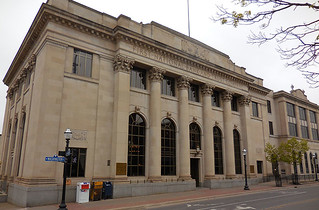 Opened in 1927, the grand Wells Fargo banking store in Marquette, Michigan, is a point of pride to the community:
Opened in 1927, the grand Wells Fargo banking store in Marquette, Michigan, is a point of pride to the community:
Intended as a “temple to banking” by benefactor/bank president Louis G. Kaufman — who donated the land and set the tone for the opulent space — the building today still shines after decades of care.
A coin room open to the public for decades features unusual and historic currency from around the world that gives visitors a unique take on financial services.
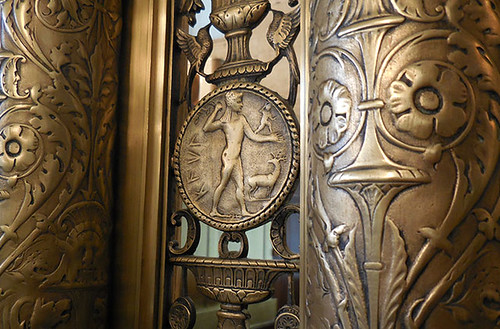
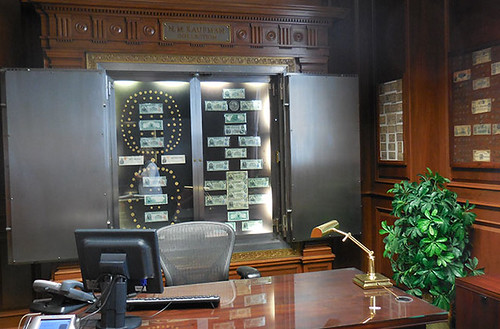
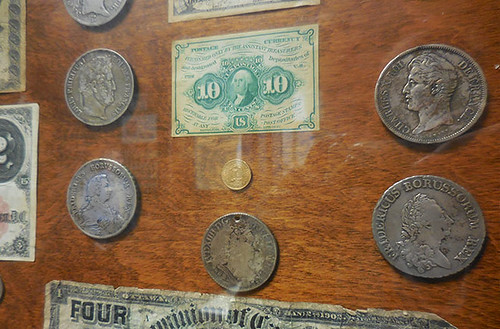
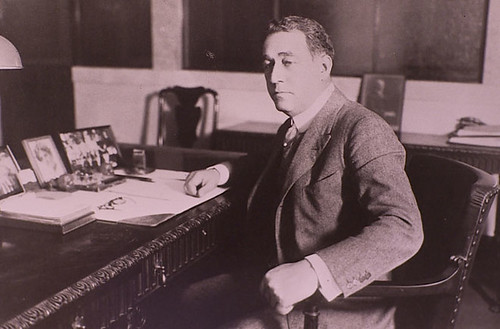
Louis Kaufman
To read the complete article, see:
‘A temple to banking’ in Michigan
(http://stories.wellsfargobank.com/a-temple-to-banking-in-michigan/)
THE BOOK BAZARRE
NUMISMATIC MENTORS AND STARTER BOOKS
Ken Bressett's Mentor: Eric Newman
Ken Bressett writes:
As a youngster living rather numismatically isolated in New Hampshire I knew of few others with my same interest in the hobby. In a rather audacious move I wrote a ‘blind’ letter to Eric Newman asking for information about the rare New Hampshire copper coin that he had in his collection. I explained that I wanted to learn more about these unusual coins and was trying to trace all known specimens.
His response, in true Newman fashion, was to mail the coin to me for examination and study. It was the start of an extraordinary mentorship that has lasted ever since - 70 years! Eric’s in-depth knowledge of numismatics is phenomenal and he is always willing to share his information with others. I have been blessed to have had Eric as both an extraordinary mentor, and even more so as a lifelong friend.
Dick Johnson's Medal Mentor: Julius Lauth
Dick Johnson writes:
I must admit I had two mentors, one for coins and one for medals, but I learned a lot from a great many people along the way.
My coin mentor was a co-worker in my father’s office who introduced me to coin collecting, taught me about mintmarks, condition, varieties and gave me a penny board and a Whitman Blue Book. That was in February 1939 when I was 9 years old.
To learn more about coin collecting afterwards included self-teaching by reading numismatic literature. Although I did learn considerable from Walter Breen. He lived for a short time in Washington DC researching at the National Archives when I was there in the Air Force.
My medal mentor was Julius Lauth, vice president and art director of Medallic Art Company. I realized the maximum amount of knowledge of coins is the minimum amount required for medals.
There was so much more to learn about medals, particularly art medals. They are made on stronger presses –knuckle-joint or hydraulic instead of coining presses. There is considerable difference in relief. Medals are given a distinctive protective finish, occasionally in color, while coins are left unfinished, just as they come off the press.
Medals are usually packaged in individual boxes with cotton protective layers. Coins are bagged to knock against each other. Even the condition is different between the two. Coins are graded by the basic fields without regard to those bagmarked nicks. Medals are graded by the presence of any nicks without regard to the basic surface (which is generally mint perfect as they do not circulate).
Julius, as well as other co-workers at Medallic Art, were always patient with me as I asked so many questions. Even as a 20-year veteran coin collector, I had a lot to learn about the associated field of numismatics -- medals.
I look back on 76 years of collecting and realize I had many mentors, most of these became long-lasting friends because we shared a common interest. I can number among those John J, Pittman, Eric Newman, Hans M.F. Schulman, James Kelly, John Jay Ford, Lee Hewitt, Daniel Friedenberg, George Fuld, Henry Grunthal, Cornelius Vermeule and perhaps half the names on the American Numismatic Association’s Wall of Fame.
Bob Rhue's Mentor: Dan Brown
Bob Rhue writes:
When I was ten years old back in '55 I walked into Dan Brown's coin shop in Denver, inquiring about how much my "treasure trove" of foreign coins that I had just gotten from my grandfather was worth.
As nicely as he could, Dan told me "nothing." Although clearly disappointed, I got to looking in his cases and saw that I could buy six different dates of Indian pennies for 25C and a little blue Whitman book to put them in for another 25C. All I had to do was mow two lawns and I'd be off and running I figured.
As my intense interest in coins continued to grow, Dan (as well as his wife Thelma who also worked in the shop), took me under his wing. He taught me many good lessons about quality versus quantity, eye appeal, and good value for the money. He trusted me to go through his safe at will, picking out coins for my budding collection. When I was in college he would send me coins on approval so that I could sell them to make extra money to buy more coins or to pay college expenses.
At one point he even co-signed a loan at a bank for me, to give you an indication of the faith he had in me and the support he gave me to become a budding part-time coin dealer.
Well into Dan's retirement years and up to the time of his death perhaps ten years ago, we remained good friends, always kept in touch, and did coin business right up to the end. His dear wife Thelma, who always called me "Little Bobby" passed away a few years after Dan.
I'll forever be grateful for Dan's encouragement, support, trust, and for his expertise which he so willingly shared with me.
David Pickup's Starter Book: Coins and Medals
David Pickup writes:
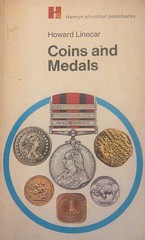 I did not have a mentor when I started but Paul Withers’ article made me think of the first books on coin collecting I had. In my very
early teens I was given a copy of Coins and Medals by Howard Linecar. This must have been a birthday or Christmas present and cost the giver
40 pence (eight shillings). Although it is an introduction written for a younger audience it is packed with information and colour illustrations.
Written by a renowned numismatist it has guidance on how to collect and where to see coins. It certainly fired my imagination.
I did not have a mentor when I started but Paul Withers’ article made me think of the first books on coin collecting I had. In my very
early teens I was given a copy of Coins and Medals by Howard Linecar. This must have been a birthday or Christmas present and cost the giver
40 pence (eight shillings). Although it is an introduction written for a younger audience it is packed with information and colour illustrations.
Written by a renowned numismatist it has guidance on how to collect and where to see coins. It certainly fired my imagination.
There do not seem to be many general introductory books on coins and collecting now. Most guides are about how to make money and avoid fakes.
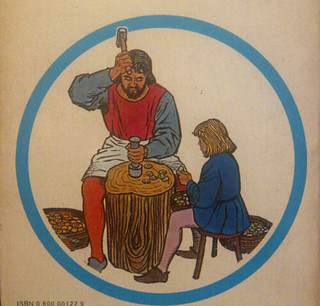
To read the earlier E-Sylum articles, see:
NUMISMATIC MENTORS (www.coinbooks.org/esylum_v18n34a27.html)
PAUL WITHERS ON NUMISMATIC WRITING
(www.coinbooks.org/esylum_v18n34a21.html)
ON CLEANING VERDIGRIS FROM COPPER COINS
Verdigris: It’s alive! And it is eating my coin.
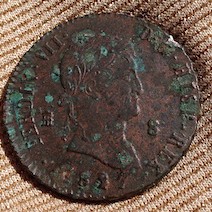

I found an nearly uncirculated 1827 8 maravidi coin in dirt removed from a 17th century church cellar here in Segovia but it had some small green blotches of verdigris on it. The coin was toned brown having passed nearly two centuries in the dirt but not in weather or water. Had it been in normal ground unprotected by a two story stone building its condition would have been a mess.
This coin would be worth $100 had it been in safe surroundings after its loss. Now it’s a curiosity worth about $20?
My dealer friend Juan Francisco had a neat trick: He scrubbed the green growth off the copper coin with a small hand brush with pure silver bristles. Presto — a coin with some hard-to-see brown spots. Now six months later — its back! The green has returned. I am told this cancer of the copper is incurable. Your experiences? I can’t find the source for the silver wire brush.
To read the earlier article, see:
NOTES FROM E-SYLUM READERS: AUGUST 23, 2015 : Query: Valuing Colonial Coins With
Environmental Damage (www.coinbooks.org/esylum_v18n34a11.html)
EDWARD HULSEMAN'S CATSKILL BANK COUNTERFEIT
Bill Groom writes:
I was in the process of writing a short article on Edward Hulseman, designer of the 1837 half cent token, HT-73, and later the 1847 Hawaiian Cent, when I happened to find the attached article. It occurs to me that E-Sylum readers might find it to be of interest.
A rough sketch of the counterfeit note is contained within the original article, but I was unable to copy that, so I wrote a brief description.
MORNING HERALD – NY City – July 27, 1840
Progress of the Morality of the Age — Daring Forgery , Also, Escape of the Forger — More Running Away — Almost every one in this city knew Hulseman, the celebrated banknote engraver in Nassau street. Well, he has engraved his last plate in this city and sloped. He has engraved a sort of semi-counterfeit $10 plate of the Catskill Bank, of which the following is a copy:
Copy of a $10 Demand Note, drawn on the NY Safety Fund. Vignettes of Mercury, a general officer and a steamboat. Dated Nov. 1, 1836 and drawn on The Catskill Bank, it was signed by cashier, H. Hill, jr. and president, Thos. B. Cook.
What renders this counterfeit extremely puzzling is, the fact that the dyes of all the vignettes, five in number, were taken from the same bad plates from which the genuine bills were printed. - These bad plates came into Hulseman's possession, it appears, in the way of trade; and the only counterfeit, there fore is in the lettering, which is extremely well done. , The signatures are very faithful copies, being first etched in the plate and then inked over afterwards. So true are they, that Mr. Cook, the president, found it difficult to tell his own signature from the counterfeit. The bills may be known by the coarseness of the paper used, and by one other curious fact, which is this: Mr Cook happened to sign a few of the $10 bills with a steel pen; this made his writing appear finer and more scratchy than usual and as we think, a little snore trembling. It so happened that Hulseman copied one of the signatures signed with a steel pen. With these exceptions, the counterfeit is perfect. Edward, Hulseman, who engraved the counterfeit, has run away, and those who catch him will do the State some service. He was convicted with Tozer in engraving notes of the "Jefferson Banking Company of Vermont," and in one or two other curious tricks. He is, by birth, a Frenchman, 35 years, old; about five feet 6 or 7 inches, thick set, dark complexion, dark hair, speaks good English, with a French accent, and takes snuff constantly — He has a disagreeable and forbidding aspect. and his looks would "hang him at Tyburn”; as they used to say, in the days of Jonathan Wild. There is a curious history connected with this affair, which we will give in full hereafter . The community are indebted to Oliver M. Lownds, Esq. for nipping this counterfeiting in the bud.
THE BOOK BAZARRE
QUERY: SOUTH CAROLINA OBSOLETE BANKNOTE HOARD
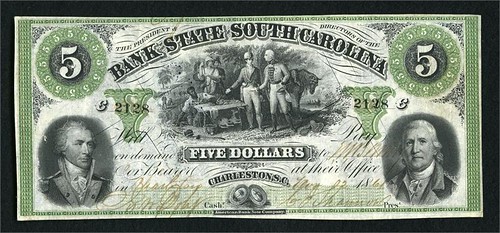
State Bank of South Carolina $5 Obsolete Currency - Potato Vignette
Original Bank Notes with Hand Written Signatures and Dates!
View and hold history in your hands with these fascinating $5 obsolete bank notes issued by the State Bank of South Carolina over 150 years ago! The Civil War started on South Carolina soil on April 12, 1861 after the Union attack on Fort Sumter. The Bank of South Carolina operated from 1812 through 1865 during which time it served as the State Treasury. It printed the only state issued notes during the Civil War.
The central vignette of General Francis Marion eating a “Sweet Potato Dinner” is one of the most famous of Southern Vignettes. Marion was known as the “Swamp Fox” and served in the Continental Army and South Carolina militia. He is considered an honorary United States Army Ranger by the U.S. military. Thomas Sumter (left) served in the South Carolina militia and was called the “Carolina Gamecock” for his fierce fighting style. Fort Sumter was named after him. General William Moultrie (right) defended Charleston and Fort Moultrie is named in his honor.
Typically redeemed notes like these were destroyed upon closure of the issuing authority. The survival of these notes is rare in Civil War and antebellum banking history. Their authenticity is unquestionable as they were bought from the South Carolina Department of Archives and History. The signatures, dates and serial number numbers are hand written, making each note a unique piece of American history that will become a treasured family heirloom passed down from generation to generation know two notes the same.
 Another image in the ad shows "The notes still tied and sealed in their original 1880 bundles were discovered in the 1950's and
transferred to the State Archives in 1961.
Another image in the ad shows "The notes still tied and sealed in their original 1880 bundles were discovered in the 1950's and
transferred to the State Archives in 1961.
I believe there is a monograph by John Muscalus on obsolete notes featuring the "Sweet Potato Dinner" vignette. Are any of our readers familiar with this hoard? Was it documented in the numismatic press? When/how was it deaccessioned from the South Carolina State Archives? One never knows quite what to believe in promotional material, but there may be an interesting story here. -Editor
To read the offering, see:
State Bank of South Carolina $5 Obsolete
Currency - Potato Vignette (www.coin-rare.com/2015-is-the-150th-anniversary-of-the-end-of-the-civil-war.aspx)
LOST HAWAII SHORT SNORTER RETURNED TO FAMILY
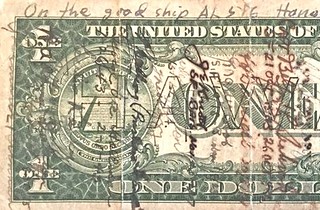 The world can seem to be an awfully big place, but then there are some stories that make it feel very small.
The world can seem to be an awfully big place, but then there are some stories that make it feel very small.
The story of Rebecca Blaesing and a dollar bill is one such example.
Blaesing, now a freelance graphic designer living in Cumberland, was working in 1993 at Victory Deli in Portland when a co-worker set aside an unusual dollar bill. It was covered with signatures, and written around the border on the back of the bill was a curious line – “On the good ship AL516 (or 86) Honolulu Oct 29 1942 short snorter Bob Scull.”
Blaesing, intrigued, bought the bill from the co-worker for $5.
“I knew it was something special,” she said, but just what that was eluded her for years. She would come across the bill from time to time and then set it aside.
She learned a few things over the years, including that “short snorters” were something of a wartime fad. Military buddies would sign dollar bills and occasionally challenge one another to produce the bill. If one of the signers didn’t have his, he had to buy a drink for the signer or signers who did.
The bill bought by Blaesing has the word “HAWAII” emblazoned across the back, a wartime measure that would allow U.S. officials to invalidate any currency that fell into Japanese hands.
Blaesing couldn’t make heads or tails out of most of the signatures, some of which had faded to the point they could no longer be read.
She came across the bill again this month and could make out “zzy” in one of the signatures. She had a friend, Jen Pozzy, in Portland and thought it might be worth it to see if there was a connection, given that “zzy” to end a name was a little unusual.
Jen Pozzy told her yes, her husband’s grandfather, Theo Pozzy, had been in the war.
“I started getting a little lightheaded,” said Blaesing, who quickly sent the Pozzy family a jpeg image of the bill.
“I saw it and said, ‘Yes, I recognize that signature,” said Alex Pozzy of Portland. In fact, he said, it looked like the signature of his brother, who idolized Theo Pozzy and emulated his signature from examples on family papers. Pozzy noted that the entire family recognized their grandfather as a hero – an oil portrait of him hangs in Alex Pozzy’s dining room.
Blaesing turned the bill over to the Pozzy family Saturday. In another bit of fortuitous timing, the Pozzy family will be having a get-together in Maine this week, so other family members will get a look at the bill.
Pozzy said his grandfather was originally from France. He came to the U.S. in 1919 and later moved to Bangor. After enlisting in the Army with the rank of captain, he spent three years in the Pacific Theater during World War II as head of the Quartermaster Corps, distributing food under the command of Gen. Douglas MacArthur. He was discharged after the war with the rank of colonel.
Theo Pozzy helped implement the Marshall Plan to rebuild post-war Europe and was awarded the Medal of the Legion of Honor by President Charles DeGaulle of France. Pozzy returned to Bangor in 1954 and became president of an electrical contracting company. He was a well-known volunteer in the Bangor area and died in 1995 at the age of 94.
Alex Pozzy said that solving one part of the mystery of the bill doesn’t answer all the questions that surround it.
For instance, the family has no idea how it came to be circulating around Portland 22 years ago – 51 years after it was signed in Hawaii.
“People are dumbfounded by it,” he said.
To read the complete article, see:
Longshot
hunch brings veteran’s 63-year-old war dollar home to grandson in Maine
(www.pressherald.com/2015/08/24/longshot-hunch-brings-veterans-63-year-old-war-dollar-home-to-grandson-in-maine/)
BANK OF CANADA URGES HALT TO 'SPOCKING'

Bank of Canada is pleading with Star Trek fans to stop “Spocking” its five dollar bills. Since Leonard Nimoy’s death, Canadian folks have been “Spocking” the hell out of the five dollar bill that features a portrait of Canada’s seventh prime minister Sir Wilfrid Laurier.
Sir Wilfrid now sports, on certain bills at least, pointy ears, the signature Vulcan haircut and eyebrows and Spock’s mantra “Live long and prosper.”
According to Bank of Canada it’s not illegal to do this but:
“...However, there are important reasons why it should not be done. Writing on a bank note may interfere with the security features and reduces its lifespan. Markings on a note may also prevent it from being accepted in a transaction. Furthermore, the Bank of Canada feels that writing and markings on bank notes are inappropriate as they are a symbol of our country and a source of national pride.”
I say Spock the hell out of ‘em if it ain’t illegal. Sir Wilfrid Laurier’s face wasn’t that interesting, anyway. In fact, let’s just make this a permanent improvement to the Canadian five dollar bill.
To read the complete article, see:
BANK OF CANADA URGES ‘STAR
TREK’ FANS TO STOP ‘SPOCKING’ THEIR FIVERS (http://dangerousminds.net/comments/bank_of_canada
_urges_star_trek_fans_to_stop_spocking_their_fivers)
To read the earlier E-Sylum articles, see:
CANADIANS HONOR LEONARD NIMOY WITH "SPOCK" NOTES
(www.coinbooks.org/esylum_v18n09a30.html)
CANADIANS ASKED TO QUIT "SPOCKING" BANKNOTES
(www.coinbooks.org/esylum_v18n10a29.html)

ISIS VIDEO SHOWS GOLD DINARS BEING MINTED
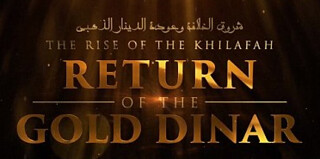 ISIS have released a new hour long video, showing off their latest propaganda tool - their very own coin currency.
ISIS have released a new hour long video, showing off their latest propaganda tool - their very own coin currency.
The video, which includes a dreary and distorted history of world economics, shows the smelting of gold, silver and copper coins. Dramatised by clips from Hollywood war films, the film accuses the US of 'confiscating Americans real wealth through an executive decree' with the introduction of the Gold Reserve Act in 1934.
Yet despite their glorification of their new currency, ISIS have no other means to pay their band of jihadis except through the use of US dollars.
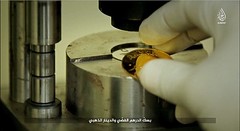 The jihadi group claim in the video that one 21-carat one dinar coin will weigh 4.25 grams and it will be worth an equivalent to $139 due
to its weight in gold.
The jihadi group claim in the video that one 21-carat one dinar coin will weigh 4.25 grams and it will be worth an equivalent to $139 due
to its weight in gold.
They also claim to have created three denominations of silver dirhams as well as two of copper coins, known as 'fulus', which will be used for 'smaller transactions.'
One of the coins has a detailed image of corn husks blowing in the wind. The corn grains appear to be an attempt by ISIS to show how the brutal jihadist group provide for their people.
Several months ago, ISIS supporters released several images of gold coins, claiming the currency would be ready in time for Eid.
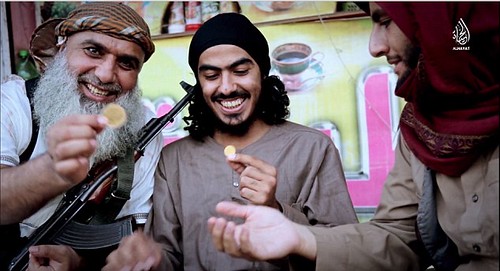
[insert your own caption here]
Dick Hanscom adds:
Is it just me or does the diameter of the 1 dinar (as shown in the photos) really not relate to a 4.25 gram gold coin?
To read the complete article, see:
ISIS release pictures of their new gold coins they say will 'break capitalist enslavement' - so why are they still paying their
deranged gunmen in US dollars?
(www.dailymail.co.uk/news/article-3215910/ISIS-release-pictures-new-gold-coins-say-break-capitalist-enslavement-paying-deranged-gunmen-dollars.html)
HOLOCAUST MONEY COLLECTION DONATED TO CLARK UNIVERSITY
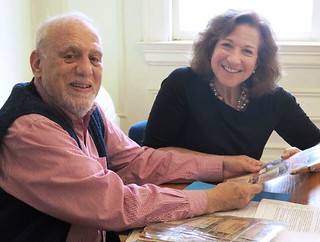 Clark University’s Strassler Center for Holocaust and Genocide Studies has acquired the Holocaust Numismatic Collection of Robert Messing
’59, of Woodstock, New York, and is making it available to students and faculty for research and classroom use beginning next month.
Clark University’s Strassler Center for Holocaust and Genocide Studies has acquired the Holocaust Numismatic Collection of Robert Messing
’59, of Woodstock, New York, and is making it available to students and faculty for research and classroom use beginning next month.
During the Holocaust, money issued in concentration camps and ghettos was part of a complex economic system that served to strip the Jewish community of its resources and further the Nazi regime’s genocidal aims. The Messing collection consists of coins and notes issued for use in Holocaust labor camps and ghettos (including Buchenwald, Lodz, Mitelbau, Terezín and Westerbork), related journals and articles, and a paper detailing how the money was created and used.
Messing, an amateur numismatist who has written widely about Jewish monetary items, graduated from Clark with a bachelor of arts in philosophy and spent 50 years in the computer automation industry. He first became interested in archeology and ancient numismatics after his first trip to Israel in 1959. He later participated in numerous archeological digs in Israel where he uncovered ancient coins, mosaics and Roman glass, and has identified and cleaned artifacts from the Temple Mount in Jerusalem. He is a founding member of the American Israel Numismatic Association.
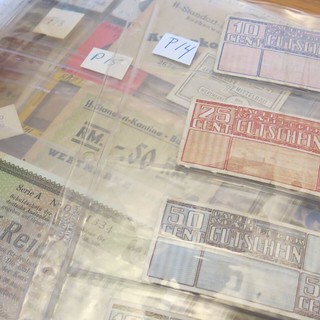 “My donation to Clark’s Strassler Center will ensure that when there are no more Holocaust survivors left to tell their story, these bills
and coins will serve as a visceral reminder to academics, scholars and all who see and touch them of a terrible history that must never be repeated,”
wrote Messing.
“My donation to Clark’s Strassler Center will ensure that when there are no more Holocaust survivors left to tell their story, these bills
and coins will serve as a visceral reminder to academics, scholars and all who see and touch them of a terrible history that must never be repeated,”
wrote Messing.
This summer, Marisa Natale ’17, a history major who concentrates in Holocaust and genocide studies, received funding from The Arthur and Rochelle Belfer Fund for Scholars of Holocaust Studies and guidance from Clark’s LEEP Center to catalogue the money and to consider how Messing’s donation could benefit Clark students in other scholarly disciplines including history, economics, and art history.
“The feeling of holding these artifacts was indescribable,” wrote Natale, “they are significant not only because of their age and historical context, but because money is an element of common experience that connects the lives of everyday people throughout history, including those who were victimized by the Holocaust.”
“The consequences of this research have the potential to be far-reaching—both in expanding our understanding of the Holocaust and our understanding of economic violence in other genocides.”
To read the complete article, see:
Clark alumnus donates rare Holocaust-era currency to the Strassler Center for faculty and student use
(http://news.clarku.edu/news/2015/08/24/clark-alumnus-donates-rare-holocaust-era-currency-to-the-strassler-center-for-faculty-and-student-use/)
MING DYNASTY NOTES: OLD, BUT NOT RARE
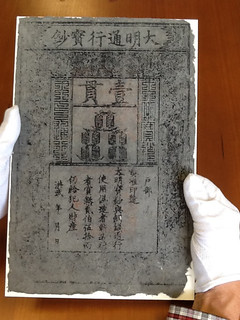 In 1923, Dr. Richard Ehrenfeld of Vienna wrote to the Metropolitan Museum of Art to announce that he had in his possession the oldest bank
note in existence, a one kwan (or guan) issue of the Ming dynasty from about the year 1375, discovered in 1888 during the demolition of an old house
in Beijing and acquired by his father, paper money collector Adolf Ehrenfeld. Richard had inherited the note and, suspecting that “European
collectors or Museums nowadays have not the money to acquire so valuable an object,” he turned to America instead, looking to part with it “should a
price approximate to the value of the note be offered me,” a figure he put at about fifty thousand dollars (roughly one million dollars today).
In 1923, Dr. Richard Ehrenfeld of Vienna wrote to the Metropolitan Museum of Art to announce that he had in his possession the oldest bank
note in existence, a one kwan (or guan) issue of the Ming dynasty from about the year 1375, discovered in 1888 during the demolition of an old house
in Beijing and acquired by his father, paper money collector Adolf Ehrenfeld. Richard had inherited the note and, suspecting that “European
collectors or Museums nowadays have not the money to acquire so valuable an object,” he turned to America instead, looking to part with it “should a
price approximate to the value of the note be offered me,” a figure he put at about fifty thousand dollars (roughly one million dollars today).
The Met passed Ehrenfeld’s letter on to the ANS, which left curator Howland Wood to deliver the bad news. His father’s note was not worth fifty thousand dollars. It was worth five dollars. Wood knew this because he had sold fourteen of them himself for that price. There were many others in New York alone, Wood told him, including several in the collections of the ANS.
The problem for Mr. Ehrenfeld, as Wood explained, was that his treasured item was not as rare as it once had been. In 1900, some European soldiers, who had been sent to China to restore peace during the Boxer Rebellion but who were instead ransacking the imperial Summer Palace, discovered a large quantity of these notes under an overturned statue of Buddha. (An entire bale of one kwan Ming dynasty notes would be discovered in 1936, hidden in an old wall outside of Beijing.) Ehrenfeld was right about one thing. Well, almost: with very few exceptions, these are the oldest examples of paper money known to have survived.
The Chinese not only invented paper, they invented paper money during the reign of emperor Chen Tsung (998-1022 AD). Examples predating the Ming notes are rarely encountered and are limited to fragments, modern facsimiles made from brass plates recovered in excavations, and a few notes reportedly held in museums. In 1988, Bank Note Reporter announced the discovery of two notes dating from 1265, one at the Hermitage Museum in Saint Petersburg and the other illustrated in a book published by the Inner Mongolia Numismatic Research Institute. These notes date from the period just before the arrival of Marco Polo at the court of the Mongol emperor Kublai Khan.
To read the complete article, see:
THE WORLD’S OLDEST SURVIVING PAPER MONEY
(www.anspocketchange.org/the-worlds-oldest-surviving-paper-money/)

PAUL WITHERS ON NUMISMATIC WRITING, PART 2
Some Thoughts On Numismatic Writing
Part 2
No matter how long your holiday actually is, once you reach the second half it feels like it’s already over. I’m sure you know the feeling. After a month in France the day of our return to the UK dawned with the sun shining from a cloudless, blue sky. After breakfast we drove to Mortain. This is the Mortain of which John Lackland, king of England 1199-1216, was count, a title which he is said to have valued above that of Lord of Ireland. These days it is a very small town, and we went there to pick up a box of oysters that we had ordered. We also bought cheeses, wine, honey cake, smoked duck breast and ham, various sausages, and other edible goodies. For the rest of the day we worked on the gunmoney manuscript until 4 pm, when we packed up, locked up and set off for the ferry. We joined the evening rush with some very impatient Frenchmen trying to hurry home at twice the speed limit, no matter what it was !
The lovely day had become a blissful, warm, summer evening, and an hour and a half later we arrived at a restaurant that has had good reviews, a couple of miles from the port. It is in a delightful village reminiscent of Devonshire half a century ago, especially the not-so-faint odour of cows. It too has history, for it is but a short walk from the Pegasus bridge of WW2 fame. Incidentally, as we left the restaurant later, the second full moon for the month showed that this was a once in a blue moon occasion. The moon is not literally blue, it’s just that there are two full moons in one calendar month, which doesn’t happen often.
The restaurant/hotel had a quiet air of comfort and relaxation, though the prices for rooms and food, displayed outside as demanded by French law, were quite affordable. We went inside and rang the bell. Eventually, someone appeared and we were ushered to seats in the dining room. The service was a little slow, but we were not in a hurry. The maitre d’ brought the menu and the wine list. Alas, we could not even consider the latter, French law is very strict on how much alcohol you can consume and still drive and in Europe you are allowed slightly less than a sniff of the barmaid’s apron before qualifying for disqualification.
We perused the delights of the menu and it all looked good, even the cheap menu, costing just 19 euros, but this was the last night of our holiday, so we chose the crab, smoked eel and langoustines starter, followed by veal.
The place was getting busy. Now, I love observing my fellow diners, and speculating about them. A French family group came in. It consisted of a man, two older women, one girl in her early 20s and a younger one who was probably celebrating her 18th birthday, and the man’s son, aged about 12. The girls, we reckoned, were cousins, not sisters. The elder of the two was elegant and sophisticated, the younger was slightly wobbly in comparison because she was wearing platform shoes. All three children, however, were capable of dealing with their half lobster when it arrived. French young people are at once so much more innocent and yet so much more experienced than Brits of the same age. Most British teenagers wouldn’t know what a lobster was, let alone how to use a lobster pick ! The younger of the girls was a typical teenager and carried a fashionably capacious black leather bag, the sole purpose of which seemed to be to contain her mobile ’phone, which was checked every few minutes, in such matters teenagers are the same everywhere.
One of the tall, young and handsome waiters, dressed casually in the house style, was eager to practise his English. He approached and enthusiastically stated “the chef wish to propose you a pea purée”. It arrived topped with whipped cream and small pieces of crispy-fried bacon, served in a shot glass. Although small, it was very good. We love this practice of serving a tiny appetiser - which the French call an amuse bouche, before the starter course. The meal was good.
We travelled overnight on the ferry and early the following morning arrived in Portsmouth. We then spent six hours driving home to Wales, most of it in bright sunshine, until we were a mile from home when it rained !
The next week we dealt with the orders that had piled up in our absence, but that’s one of the perils of being a small business and going away.
We soon got down to reviewing our findings. The first was that the gunmoney coinage was much larger than we had thought. Exactly how large ? Certainly there are 50+ pairs of dies for the crown. However, our knowledge was derived from only one collection, so we now had to examine other collections and compare them to our virtual reference collection. Hence, a week after getting home, we were off again to look at the collection of the Fitzwilliam Museum in Cambridge. From e-mail and telephone conversations we knew that they had over two hundred pieces, not large, but nevertheless fairly substantial.
We allowed three days for our trip: one day to get there, one day to do the photography, and another day to get back. Several other errands were also planned, including seeing another, much smaller, collection of gunmoney. When you are compiling a catalogue, though, you look at everything, regardless of size.
Being aged, we have accumulated friends around the country; luckily, one of them lives near Cambridge. We arrived at our friend’s house after visiting the local supermarket. We had been to the nearest supermarket so came bearing gifts: tiger prawns, steak, chicken thighs, a big pack of lamb’s kidneys, and a few other odds and ends: the makings of two good dinners: a prawn and chicken risotto one night, and a steak and kidney stew for the following day, along with two bottles of wine, a white from Chile and a red from Spain. The French, of course do not encourage the sale of non-French wines in their supermarkets, but French wines are becoming expensive in the UK, and we care about quality, not nationality. Our friend lives alone, so he was delighted to see us, particularly as we had promised to cook whilst we were there.
The Fitzwilliam museum is a normally a place of quiet calm, but we had not realised that it was the school holidays. So the galleries were full of shrieking children, but fortunately, we were in the coin room. It is a wonderful museum and the staff are both accommodating and helpful, but if you want to see coins that are not on display, make an appointment well in advance. Before we left we downloaded the photographs from camera to computer and checked each one on the screen. We know from bitter experience that it is all too easy to forget to photograph a reverse, or for a shot to be slightly out of focus. So you check and double check, for as sure as eggs is eggs, the one shot that you miss, or is out of focus is the one that according to Sod’s law will be the one that you really need ! All was well, it had been a worthwhile day.
So, a successful trip, errands completed, photographs taken, it was back home to process the pictures and digest the results. So far I have written plenty about writing, but said nothing about photography, and with, allegedly, one photo being worth a thousand words, I now remedy this.
I took my first photograph on a ‘box’ camera 65 years ago. In subsequent years, I have found with cameras (and computers) that it is no good chopping and changing, get a good one, learn how to use it, and stick with it. In the days before digital photography I used an F2 Nikon, which I wore out. I processed my own films and printed my own negatives. Why ? Because the only way to be sure of getting the quality that I wanted was to do it myself.
I don’t do ‘arty’ pictures, and when I go on holiday, I take a small, cheap digital camera and the ‘work’ camera and its stand are consigned to the strong room whilst we’re away.
For coins, I need good record photographs, so I use the same camera setting each time, to keep it nice and easy. If you follow the same plan and pattern each time there is less that can go wrong. There are several important rules:
1. Keep the camera still: mine sits in a cradle on a solid, heavy, robust laboratory stand that was built for Michael Dolley. I inherited it from the late Elizabeth J E Pirie, a lovely lady numismatist who is still an inspiration.
2. Use a spirit level to ensure that the camera is parallel to the coin being photographed.
3. Get the lighting right. There is insufficient space here to explain that here, but basically, you take the lamp, point it at the coin and take a series of photographs at varying angles to the vertical and the horizontal, noting precisely what you have done and look critically at the results. I still do this now and again even after half a century’s experience. Sunlight ? Wonderful stuff for a tan, but for book illustrations, forget it. You need a light source that is reliable, consistent and repeatable and one that that you can switch on and off at all times of the year, and any time of the day or night.
4. The camera that I use has a white balance facility to make sure that the resulting image looks exactly like the coin.
What camera ? We use a Canon Eos with a 50mm Canon macro lens, the nearest available equivalent now seems to be the 70D. However, I am sure that there are others, which are equally good. I bought it, not from a box shifter on the internet, but it in person from a dealer, one who knows his wares and can give good advice, and who has a selection of cameras for customers to handle, prior to making the choice, this is well worth the few pounds that I might have saved. You really don’t need a massive number of megapixels if all you want is pictures of coins of a moderate size. 10 megapixels is more than sufficient. Many of my best pictures were taken with a camera that had a lot less ! Remember too that you have to be able to set the focus and the aperture yourself, automatic is all very well, but I prefer to switch it off and do it myself. Automatic cameras often get things wrong. You don’t need video or other bells and whistles. If you get the lighting and the settings right, little processing is required, apart from trimming the images. Indeed, for most of my photographs I can press the ‘auto levels’ button in Photoshop and there is little or no change. One essential accessory, for coins that will appear in a book, is a light box, on which to put the item being photographed to ensure a shadow-free, clean background. Sure, you can clean up one or two pictures by hand, but if there are hundreds it becomes very tedious.
On our computers we use an old version of iPhoto that came bundled with our last but one Mac. This enables us to compare and view large numbers of photographs, and put them into the order and add, or remove, when necessary. This is essential when comparing dies.
One of the things we discovered from looking at the photographs of the coins was that there were remarkably few mules between the gunmoney obverse and reverse dies within a month, and apart from the later issues struck at Limerick, after the Battle of the Boyne, none known between months.
Our observation says that pairs of dies were used practically to destruction, and then the pair abandoned, even if there was life left in one of them.
How many pairs of dies were used ? Certainly, for some months, the Dublin mint was using dies at a rate greater than a pair per day, per denomination. So we can say that the coinage was vast, and we are still finding exactly how large.
Sadly, the lack of mules means that we are unable to establish a chronological sequence for the dies. However, the good news is that it does mean that we can classify the coins, other than the crowns, by their reverse dies, which is good as the obverses are much more difficult to classify than the reverses.
We hope that the system that we have developed will enable people to find their coin quickly and easily, providing, of course, that the coins are complete, adequately struck up and not detrited. Indeed we have been able to identify the month of issue of some coins, even when it was not visible on the coin due to corrosion, damage, holing, etc. We have classified the obverses too, so we can use them to check that the pairing is correct. However, to find out what the system is, you’ll have to buy the book when it’s printed and published ! For the moment we have put the photographs away. We have established from having seen the Fitzwilliam museum collection and another collection, that apart from large-size shillings, we are within our 5% criterion, which means that we could already publish a reasonably good catalogue now. However, to make it the best possible catalogue, we need to visit Dublin and the Ashmolean museums to photograph their collections, and British Museum to see what they have, and that depends on us finding windows of opportunity at a time when there are fewer tourists around.
So, there’ll be at least one more episode of this chronicle to come, with this part of the story ending with our return from France, when our first task was to arrange a dinner party for a few selected friends to celebrate our return to the UK, the work we had done in France and the French food we had brought back. Numismatics is the day job and a bit more, but after hours our hobby is food.
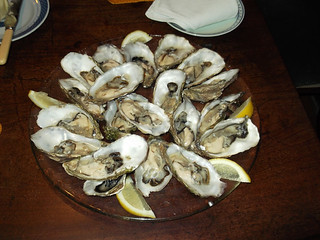 We started the celebration of the joy of food with an amuse bouche, before the oysters. They were not small oysters, they are on a large
charger, and there was a refill waiting. Incidentally, none were wasted !
We started the celebration of the joy of food with an amuse bouche, before the oysters. They were not small oysters, they are on a large
charger, and there was a refill waiting. Incidentally, none were wasted !
Saki wrote “I think oysters are more beautiful than any religion. They not only forgive our unkindness to them; they justify it, they incite us to go on being perfectly horrid to them. Once they arrive at the supper-table they seem to enter thoroughly into the spirit of the thing. There's nothing in Christianity or Buddhism that quite matches the sympathetic unselfishness of an oyster. ”
One might also say that there is nothing that quite matches their taste either, or the generosity of a friend who stands in the kitchen for an hour shucking them. Bon appétit !
To read the earlier E-Sylum article, see:
PAUL WITHERS ON NUMISMATIC WRITING
(www.coinbooks.org/esylum_v18n34a21.html)
CANADA'S $20 NORTHERN LIGHTS COIN
 The Royal Canadian Mint unveiled a new northern-themed collectors' coin in Whitehorse Monday.
The Royal Canadian Mint unveiled a new northern-themed collectors' coin in Whitehorse Monday.
The $20 silver coin — retailing for more than $100 — features a raven set against a holographic sky of northern lights.
Alex Reeves, communications manager with the Mint, says the coin's unveiling coincides with a meeting of the Mint's executive and board of directors in Yukon this week.
Local politicians and First Nations leaders were at the Kwanlin Dün Cultural Centre to see the new coin.
According to the mint only 8,500 of the new coins will be produced.
The coin, called "A story of the Northern Lights: Raven," was designed by Ontario-based Métis artist Nathalie Bertin.
To read the complete article, see:
Royal Canadian
Mint's new $20 coin has northern lights, raven
(www.cbc.ca/news/canada/north/royal-canadian-mint-s-new-20-coin-has-northern-lights-raven-1.3202311)
KÜNKER AUCTION SALES 265-270
September 26th – October 2nd, 2015
Fritz Rudolf Künker, Osnabrück
Auction 265-270
Künker Fall Auction Sale Week: Six Auctions, About 7,600 Lots, Many Special Collections
Over the course of six days, the city of Osnabrück will witness a spectacular event when nearly 7,600 lots of superb numismatic items with a total estimate of more than 10 million euros will cross the auction block. The sessions will be composed of a wide range of highlights and surely impress with their numbers of special collections offered for sale.
From September 26th, 2015 to October 2nd, 2015 the numismatic world will once again gather at the Steigenberger Hotel Remarque to experience six days of auctions offering a multitude of highlights, special collections and rarities. Let us have a brief look at the stars of this six day auction event: orders and decorations from around the world, a special collection Minden, Swedish numismatic rarities, the largest collection of Brandenburg in Franconia ever to be on the market, gold and silver coins of the Archbishopric of Salzburg, a perfect Catane tetradrachm and Roman gold coins of the finest grades. Surely, this broad array of numismatic diversity, brought together in six auction catalogs, lets every collector find his or her favorite item.
Auction 265: Orders and Decorations from around the World
The 12th phaleristic Künker auction consists of more than 900 lots of world orders and decorations. The sale focuses on civil and military
decorations of the Kingdom of Prussia. The most important item of this segment will very likely be the only Grand Cross Badge of the
Military Order of St. Charles Eugene of Wuerttemberg made of gold and enamel. It is the only specimen known to exist. With the Order’s
founder in attendance, this badge was awarded to General Jean-Baptiste-Joseph de Maillard de la Martinière, Baron de Gorcy in 1759.
Also on the auction block will be the very well documented estate of Colonel Paul-Hermann Werner, comprising Knight’s Crosses. Colonel Werner was the most important commander of the legendary Panzerregiment 31, nicknamed “Red Devils.” The heart of the material from foreign countries constitutes a collection of orders and decorations from Scandinavia. And lastly, there will be rarities from Austria, Belgium, France, Great Britain, Italy, Poland, Portugal and Russia.
189 Duchy of Wuerttemberg: Military Order of St. Charles of Wuerttemberg, Grand Cross Badge (Commander). Issue from 1759, gold and enamel. Extremely rare. II-II. Estimate: 20,000,- euros
356 Kingdom of Denmark: Order of the Dannebrog, Grand Cross Badge from the reign of King Christian VIII (1839-1848). Gold, enamel, diamonds. Extremely rare. I-II. Estimate: 25,000,- euros
595 Republic of Portugal: Military Order of Christ. 3rd model (since 1918), Grand Officer Breast Star of the Order in brilliants, gold, enamel, and simili stones. Extremely rare. II. Estimate: 20,000,- euros
620 Russian Empire: Order of Saint Andrew, Breast Star in brilliants. Non-Russian issue, silver, gold, enamel and simili stones. I-II. Estimate: 20,000,- euros
Auction 266: Coins and Medals from Medieval and Modern Times / Russian Coins and Medals
The second day of the Künker Fall Auction Sale Week will kick off with pre-1871 Germany. We would like to highlight an exceptional small
collection of Minden and more than 200 lots from Saxony, including the famous trinity medal created by Hans Reinhart the Elder, estimated
at 5,000 euros, and the 1780 konventionsthaler for diligence in the finest grade, estimated at 6,000 euros.
The multiple lots assembled by Künker are also always worth a closer look, notably a special collection of reckoning counters adding up to a total of 1,460 specimens which, as a package, will be called out for 25,000 euros.
The following lots of coins and medals from abroad will also offer many rarities and this time the Swedish coins exceed all expectations. There are about 120 lots listed in the catalog, including unique specimens and coins of utmost rarity. Spectacular features of this section are a 1540 salvatordaler struck in Västeras, which represents the second specimen known to be in a private collection (estimate: 2,500 euros). Furthermore, the Swedish segment will feature a 1649 double riksdaler from the mint of Stockholm, which used to call the Bonde Collection its home, even prior to 1874 (estimate: 100,000 euros).
Lastly, Russian coins and medals will conclude Auction 266. As always, the connoisseur will find some truly remarkable individual items in superb grades. It is hard to say what these specimens will obtain in the auction. One such specimen is a seemingly unspectacular, but very rare 1731 10 kopeck piece with a very interesting feature: through 10 dots on the reverse even the illiterate user was able to determine the value of this little coin (estimate: 2,500 euros). Last but not least, a gold medal commemorating the coronation of Tsar Alexander II will be on sale. This extremely fine specimen weighs 173.37 g and has a pre-sale estimate of 50,000 euros.
Lot 1335: GERMANY. Münster. 1683 schauthaler probably by G. Storp on the siege and the relief of Vienna. Extremely rare. Extremely fine. Estimate: 20,000,- euros
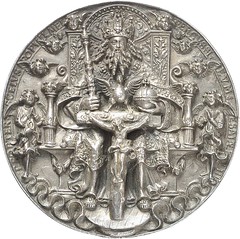
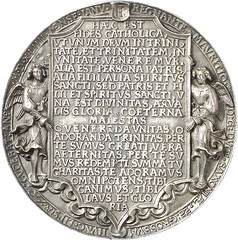
Lot 1432: GERMANY. Saxony. Cast silver medal, trinity medal or moritzpfennig, 1544 (probably made around 1600) by Hans Reinhardt the Elder. Extremely fine. Estimate: 5,000,- euros
Lot 1557: GERMANY. Saxony. Frederick August III (I), 1763-1806-1827. 1780 konventionsthaler, Dresden, on diligence. Very rare. FDC. Estimate: 6,000,- euros
Lot 1664: GERMANY. Würzburg. Axel Oxenstierna, 1633-1634. Reichsthaler n. d. (1633/34), Würzburg. Very rare. Extremely fine to FDC. Estimate: 25,000,- euros
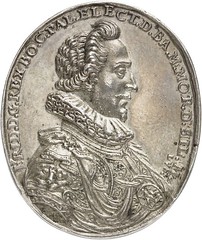
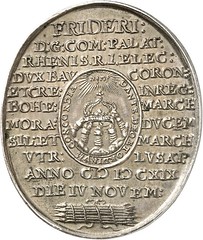
Lot 1706: HRE. Frederick Elector Palatine, 1619-1621. Struck oval-shaped silver medal, 1619, by Chr. Maler on the coronation as King of Bohemia. Extremely rare. Extremely fine to FDC. Estimate: 12,500,- euros
Lot 1796: GREECE. George I, 1863-1913. 2 drachmae 1911 A, Paris. Extremely rare. Nearly FDC. Estimate: 15,000,- euros
Lot 1870: ITALY. Trient. Bernardo II di Clesio, 1514-1539. 1520 tallero, Hall. Dickstück. Extremely rare. Very fine. Estimate: 20,000,- euros
Lot 1947: SWEDEN. Gustav Vasa, 1521-1560. 1540 daler, Västeras. 2nd specimen known to be in private possession. Good very fine. Estimate: 50,000,- euros
Lot 1987: SWEDEN. Christina, 1632-1654. 2 riksdaler 1649, Stockholm. Ex Bonde Coll. Extremely rare. Extremely fine. Estimate: 100,000,- euros
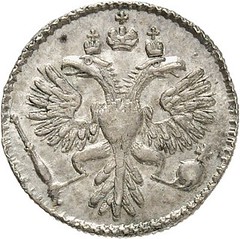
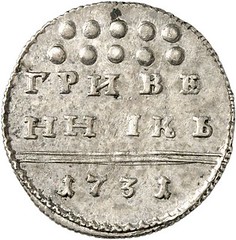
Lot 2237: RUSSIA. Anna, 1730-1740. 10 kopecks 1731, Moscow, Kadashevsky Mint. Very rare. Nearly extremely fine. Estimate: 2,500,- euros
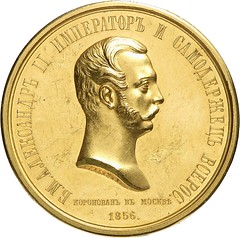
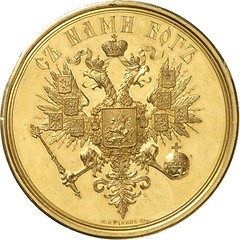
Lot 2401: RUSSIA. Alexander II, 1855-1881. Gold medal of 50 ducats 1856 by A. Lyalin and M. Kuchkin on the coronation of Alexander. Very rare. Extremely fine. Estimate: 50,000,- euros
Lot 2487: RUSSIA. Nicholas II, 1894-1917. Golden prize medal from the Main Department of State Horse Breeding for the best race horse. Very rare. Extremely fine. Estimate: 15,000,- euros
Auction 267: Brandenburg in Franconia and the Franconian Imperial Circle – The Roland Grüber Collection
The Roland Grüber Collection is an incredible work of a lifetime. As an avid and meticulous coin collector Mr Grüber collected a great number of coins and medals related to Brandenburg in Franconia over the last two decades. It is not hard to see how much work this collection thrived off and how many hours of research were spent in order to locate the pieces. As it befits a real collector Mr Grüber not only chose exclusive specimen to be part of his collection but also included everyday change related to the topic. On the one hand this offers a very round picture of the subject, and on the other it offers lot estimates which vary between 10 and 25,000 euros.
To try to even present a selection of highlights of the Roland Grüber Collection is a hard thing to do, when there are so many the spotlight can be on. But here are a few: a unique gold gulden of Burgrave John III (1415-1420) from Neustadt and der Aisch (estimate: 10.000 euros), a 1579 gold gulden commemorating the “Steel Shooting” (“Stahlschießen”) at Plassenburg near Kulmbach on the occasion of the wedding of George Frederick (estimate: 20.000 euros), a triple 1676 reichsthalerklippe celebrating a bird shooting competition in Dresden (estimate: 20.000 euros), a unique 1629 5 ducat piece, bearing the portraits of the Margraves and brothers Frederick, Albert and Christian (estimate: 20.000 euros), and a golden achievement medal of 10 ducats (estimate: 10,000 euros). This medal from around 1780 was created by John Samuel Götzinger for the Margrave Frederick Charles Alexander and was chosen as the cover illustration of this catalog.
Last but not least, the Roland Grüber Collection also includes almost 400 lots featuring Franconia and the Bavarian Crown, cities and estates located in Franconia, individuals related to the subject of Franconia, the time of the Swedish occupation of Franconia, the Franconian Imperial Circle and medals created by the medalists of the Reich family, based in the city Fürth.
Lot 3043: BRANDENBURG IN FRANCONIA. John III, 1404-1420. Gold gulden n. d., Neustadt an der Aisch. Ex SBV Auction 15 (1986), 277. Unique. Very fine. Estimate: 10,000,- euros
Lot 3280: BRANDENBURG IN FRANCONIA. Albrecht Alcibiades, 1541-1554. Gold gulden 1549, Schwabach. Ex Hess-Divo Auction 305 (2006), 409. Only specimen known to be in private possession. Very fine. Estimate: 10,000,- euros
Lot 3295: BRANDENBURG IN FRANCONIA. George Frederick the Elder, 1556-1603. Gold gulden 1579, Schwabach, on the steel shooting competition (“Stahlschießen”) in Kulmbach on the occasion of his wedding. Only specimen known to be in private possession. Very fine. Estimate: 20,000,- euros
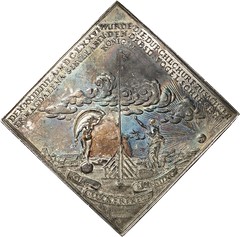
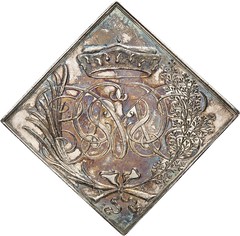
Lot 3626: BRANDENBURG IN FRANCONIA. Triple reichsthalerklippe 1676, Dresden, on the bird shooting competition in Dresden on July 23, where the electoral prince (later to be Prince Elector John George III) fired the decisive shot, thus making his mother Magdalena Sibylla become queen of shooters. Ex Peus Auction 364 (2000), 1671. Very rare. Extremely fine to FDC. Estimate: 20,000,- euros
Lot 3847: BRANDENBURG IN FRANCONIA. Gold medal of 25 ducats 1737 by George William Wahl on the death of Sophie Christiane of Wolfstein, wife of Margrave Christian Heinrich. Ex Partin Auction 16 (1983), 18. Only seven gold specimens struck. Extremely fine. Estimate: 10,000,- euros
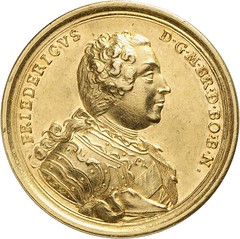
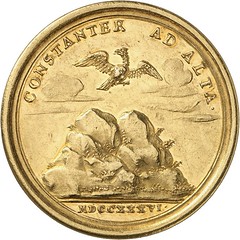
Lot 4014: BRANDENBURG IN FRANCONIA. Frederick, 1735-1746. Gold medal of 10 ducats 1736 by Peter Paul Werner. Very rare. Extremely fine. Estimate: 10,000,- euros
Lot 4209: BRANDENBURG IN FRANCONIA. Frederick, Albrecht and Christian, 1625-1634. 5 ducats 1629, Nuremberg. Unique. Extremely fine. Estimate: 20,000,- euros
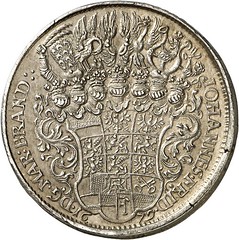
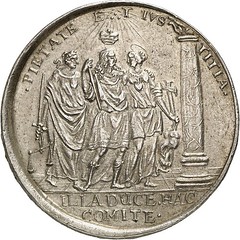
Lot 4243: BRANDENBURG IN FRANCONIA. John Frederick, 1667-1686. Thick double reichsthaler 1679, Schwabach. Unique. Extremely fine. Estimate: 20,000,- euros
Lot 4868: BRANDENBURG IN FRANCONIA. Christian Frederick Charles Alexander, 1757-1791. Golden achievement medal of 10 ducats n. d. (around 1780) by John Samuel Götzinger. Ex Heidelberger Münzhandlung Auction 11 (1994), 1510. Extremely rare. FDC. Estimate: 10,000,- euros

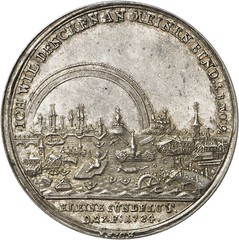
Lot 5236: BRANDENBURG IN FRANCONIA. Silver medal 1784 by John Christian Reich on the flood of the city of Nuremberg and the water shortage in Europe. Ex Baums Coll., Künker 247 (2014), 5921. Very rare. Extremely fine to FDC. Estimate: 5,000,- euros
Auction 268: Coins and Medals of the Archbishopric of Salzburg – The Numitor Collection
The afternoon of September 30th, 2015 will be devoted to gold coins and thaler-like coins of Salzburg when the Numitor Collection will be
auctioned off. With all the great rarities and many unique specimen present, of which all are of the best grade possible, this collection
can truly serve as an illustrated book of cultural history. The spectrum of numismatic items ranges from the first gold gulden of Pilgrim
II of Puchheim (1365-1396), to various fractions of the famous rübenthaler (which is a guldiner, needless to add), to the golden tower
coins of Wolf Dietrich of Raitenau (with all denominations between 3 ducats and 10 ducats), to the so-called 1790 löwenthaler of the last
Prince Archbishopric of Salzburg, Hieronymus of Colloredo.
The item with the currently highest appraisal of this auction sale is a 10 ducat tower coin from 1594, estimated at 100.000 euros. Another five coins, each estimated at 75.000 euros, also have a good chance of obtaining new record prices: an undated gold gulden of Sigismund of Volkersdorf, a quintuple dukatenklippe of Matthew Lang of Wellenburg, which was struck from a magnificent die made by Ulrich Ursenthaler the Elder, a 1565 12 ducat piece of John Jacob Khuen of Belasi, a 1686 10 ducat piece commemorating the ordination to cardinalhood and finally, the above mentioned 1790 löwenthaler.
It is important to point out, that not all the coins of this spectacular collection are estimated in the five-digit region. Every collector can find interesting material and the appraisals start at 150 euros.
Lot 5502: SALZBURG. Sigismund of Volkersdorf, 1452-1461. Gold gulden n. d., Salzburg. 2nd specimen known to exist. Extremely fine. Estimate: 75,000,- euros
Lot 5513: SALZBURG. Matthew Lang of Wellenburg, 1519-1540. Quintuple dukatenklippe 1522. Die made by Ulrich Ursenthaler the Elder. Ex Fürstenberg Coll., Helbing, Munich (1932), 281. 2nd specimen known to exist. Extremely fine. Estimate: 75,000,- euros
Lot 5548: SALZBURG. John Jacob Khuen of Belasi, 1560-1586. 12 ducats 1565. Ex Hamburger Auction (1921), 59. 2nd specimen known to exist. Very fine. Estimate: 75,000,- euros
Lot 5581: SALZBURG. Wolf Dietrich of Raitenau, 1587-1612. 10 ducats 1594. Tower coinage. Extremely rare. Extremely fine. Estimate: 100,000,- euros
Lot 5640: SALZBURG. Max Gandolph of Küenburg, 1668-1687. 6 ducats 1682 on the 1,100th anniversary of the archbishopric. Extremely rare. Nearly FDC. Estimate: 30,000,- euros
Lot 5727: SALZBURG. Hieronymus of Colloredo, 1772-1803. 1790 Löwenthaler. Ex Leu Auction 75 (1999), 1100. Extremely rare. Nearly FDC. Estimate: 75,000,- euros
Auction 269: Gold Coins / German Coins after 1871
Auction 269 is entirely devoted to gold coins and German coins after 1871. It goes without saying that this auction sale offers a great
number of rarities. To name just a few: 100 and 20 drachmai pieces from 1940, struck on the occasion of the 5th anniversary of the return
of George II of Greece from exile (estimate: 15,000 and 12,500 euros), British 5 guinea pieces, Italian rarities such as the 1/2 carlino of
Victor Amadeus III of Sardinia, struck in Turin in 1786 (estimate: 17,500 euros), and a doppia oncia d’oro of Ferdinand III of Sicily,
depicting the triskeles on its reverse, minted in Palermo in 1814 (estimate: 15,000 euros).
The highlights from pre-1871 Germany are a Bavarian 8 ducat piece paying homage to Maximilian I (estimate: 30,000 euros), a double karolin of Charles Albert of Bavaria and his wife, on the founding of the Royal Military Order of Saint George for the Defense of the Faith and the Immaculate Conception in 1729 (estimate: 30,000 euros), as well as a 6 ducat piece from Nuremberg, struck under Swedish occupation by Gustavus II Adolphus in 1632 (estimate: 50,000 euros).
Among the German coins produced after 1871, a particularly interesting pattern can be found. This 2 mark piece bears the date of 1950 and was only struck in small numbers by the Munich mint (estimate: 7,500 euros).
Lot 6178: GREECE. George II, 2nd reign, 1935-1947. 100 drachmae n. d. (1940), Birmingham, struck on the occasion of the 5th anniversary of his return from exile to Athens on November 25, 1935. Ex UBS Auction 63 (2005), 3279. Only 140 specimens struck. Nearly FDC from Proof. Estimate: 15,000,- euros
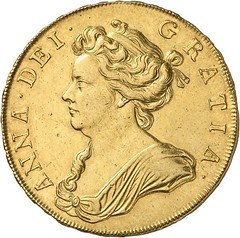
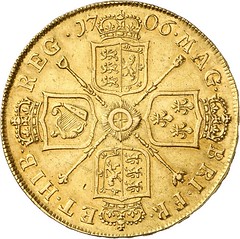
Lot 6192: GREAT BRITAIN. Anne, 1702-1714. 5 guineas 1706, London. Vogel Coll., ex Künker Auction 230 (2013), 6656. Very rare. Extremely fine. Estimate: 20,000,- euros
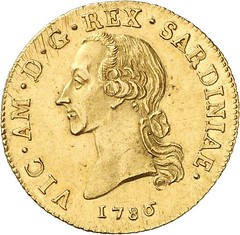

Lot 6329: ITALY. Sardinia. Victor Amadeus III, 1773-1796. 1/2 carlino of 2.5 doppie 1786, Turin. Ex Künker Auction 207 (2012), 6305. Very rare. Extremely fine. Estimate: 17,500,- euros
Lot 6368: ITALY. Sicily. Ferdinand III, 1759-1816. Doppia oncia d’oro 1814, Palermo. Ex Künker Auction 160 (2009), 4339. Very rare. Extremely fine. Estimate: 15,000,- euros
Lot 6604: CHINA. Republic. Gold dollar, year 10 (1921) on the proclamation of Hsu Shih Chang as president in October 1918. Graded NGC MS 62. Very rare. Extremely fine to FDC. Estimate: 25,000,- euros
Lot 6809: GERMANY. Bavaria. Charles Albert, 1726-1745. Double karolin 1729, Munich. Vogel Coll., ex Künker Auction 221 (2013), 8140. Very rare. Extremely fine. Estimate: 30,000,- euros
Lot 6914: GERMANY. Nuremberg. 6 ducats 1632, minted under Swedish occupation by Gustavus II Adolphus. Oldenburg Coll., ex Bukowski Auction 113 (1898), 1396. Extremely rare. Very fine to extremely fine. Estimate: 50,000,- euros
Lot 7375: FRG. Pattern for 2 DM 1950 D. Extremely rare. Nearly FDC. Estimate: 7,500,- euros
Auction 270: Coins from the Ancient World
In the final sale of the Künker Fall Auction 1,230 lots, comprising coins from the ancient world, will be auctioned off. The session will
start off with two real gems, which are both icons of Celtic numismatics. The first is a gold stater of the Parisii and its stylized design
strikes almost as modern (estimate: 25,000 euros). The second piece is a Pannonian imitation of the crested rider type tetradrachms of
Philip II, which reads an enigmatic legend (estimate: 25,000 euros).
But this is only the beginning of the sale. An impressive series of Sicilian tetradrachms includes an outstanding piece from Catane, featuring the facing bust of Apollo, signed by Heracleidas. The coin derives from the Jameson Collection, which is one of the best provenances a collector can aspire to call his or her own (estimate: 100,000 euros). But also the Syracusian tetradrachm, signed by Euainetos, has an outstanding provenance: It was once part of the Virzi Collection, which in 1912 was sold at a Jacob Hirsch auction in Munich (estimate: 50,000 euros). Further highlights from the Greek department are: a tetradrachm from Ainos (estimate: 10,000 euros), a distater of Alexander the Great (estimate: 10,000 euros), two gorgeous specimens from Crete – a stater from Phaistos (estimate: 10,000 euros) and a stater from Polyrhenia (estimate: 5,000 euros), an Archaic stater from Karpathos (estimate: 10,000 euros), and an extremely fine tetradrachm, depicting the facing head of Helios from Rhodes (estimate: 25,000 euros).
There will also be a small special collection of Judean coins offered for sale. It features silver shekels of both Jewish-Roman wars in superb conditions. From the first Jewish-Roman war a shekel (estimate: 35,000 euros) and a half shekel (estimate: 7,500) of year 1 will be on sale and from the second Jewish-Roman war a tetradrachm of year 3 will be on the auction block (estimate: 5,000 euros).
Even rarer is the perfect gold stater of Eucratides I, minted in Pushkalavati (estimate: 75,000 euros) and the pentadrachm of Berenice II from Alexandria (estimate: 40,000 euros).
From the Roman department the perfect aurei certainly stand out. And only a few names may suffice: Vitellius (estimate: 50,000 euros), Vespasian (estimate: 25,000 euros), Hadrian (estimate: 30,000 euros), Lucius Verus (estimate: 20,000 euros), Crispina (estimate: 50,000 euros) Didius Julianus (estimate: 35,000 euros), and Licinius (estimate: 40,000 euros). The highest estimate comes for a solidus of Crispus, struck in Nicomedia in 324. It exhibits an unusual, heroic nude bust of the imperial son to the left, holding shield and spear. This particular piece comes from the Vierordt and Mazzini Collection (estimate: 100,000 euros).
When turning to Silver and Bronze, the collector will also discover many magnificent items. Anyone interested in Roman history will also be pleased to find a special collection of Roman Imperial Bronzes. It was assembled by a historian and pedagogue, whose historical interests outweighed the perfect condition of an item.
The catalogs may be ordered at Künker, Nobbenburger Straße 4a, D-49076 Osnabrück; phone + 49 541 96202 0; telefax: + 49 541 96202 22; or by writing an email: service@kuenker.de. All coins on offer can be viewed online at www.kuenker.de/en
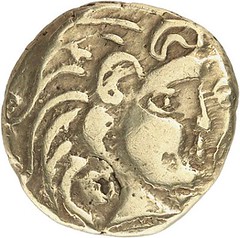
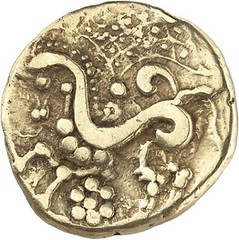
Lot 8006: CELTS. Parisii. Gold stater, 2nd / 1st cent. BC. Very rare. Nearly extremely fine. Estimate: 25,000,- euros
Lot 8047: CELTS. Pannonia. Tetradrachm, Crested rider type, c. 150 BC. Ex Kress Auction 135 (1966), 219. Extremely rare. Extremely fine. Estimate: 25,000,- euros
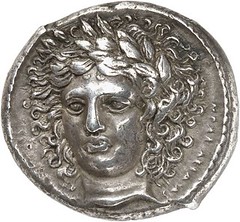
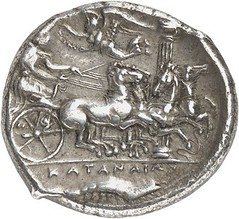
Lot 8117: GREEKS. Sicily. Catane. Tetradrachm, c. 405/402, signed by Herakleidas. Ex Jameson Coll. 547. Very rare. Extremely fine. Estimate: 100,000,- euros
Lot 8135: GREEKS. Sicily. Syracuse. Decadrachm, after 405, signed by Euainetos. Virzi Coll., ex Hirsch Auction 32 (1912), 322. Very rare. Extremely fine. Estimate: 50,000,- euros
Lot 8379: JUDAEA. 1st Jewish Revolt, 66-70. Shekel, year 1 (66/67), Jerusalem. Very rare. Extremely fine. Estimate: 35,000,- euros
Lot 8410: BACTRIA. Eucratides, 170-155. Attic stater, Pushkalavati. Extremely fine. Estimate: 75,000,- euros
Lot 8541: ROMAN REPUBLIC. Marc Antony / Octavian. Aureus, 41 BC., Ephesus. Very rare. Nearly extremely fine. Estimate: 75,000,- euros
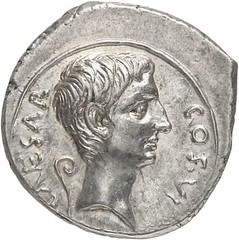
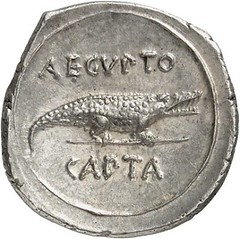
Lot 8549: ROMAN IMPERIAL TIMES. Augustus, 30 BC – AD 14. Denarius, 28 BC, Italian mint. Ex Tkalec Auction (2011), 134. Very rare. Extremely fine to FDC. Estimate: 35,000,- euros

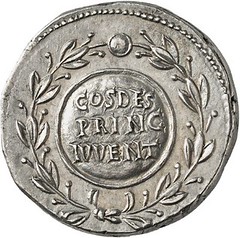
Lot 8606: ROMAN IMPERIAL TIMES. Nero. Cistophorus, 51, Asia Minor. Very rare. Extremely fine. Estimate: 2,500,- euros
Lot 8642: ROMAN IMPERIAL TIMES. Vitellius. Aureus, Rome. Ex Lanz Auction 135 (2007), 569. Very rare. Tiny scratches, expertly restored. Extremely fine. Estimate: 50,000,- euros
Lot 8650: ROMAN IMPERIAL TIMES. Vespasian. Sestertius, 71, Rome. Ex Vinchon Auction (1976), 46. Very rare. Extremely fine. Estimate: 50,000,- euros
Lot 8827: ROMAN IMPERIAL TIMES. Lucius Verus. Aureus, 163/4, Rome. Ex UBS Auction 75 (2008), 1059. FDC. Estimate: 20,000,- euros
Lot 8828: ROMAN IMPERIAL TIMES. Lucius Verus. AE-medallion, 164/5, Rome. Ex Kastner Auction 4 (1973), 251. Extremely rare. Extremely fine. Estimate: 25,000,- euros
Lot 8836: ROMAN IMPERIAL TIMES. Didius Julianus. Aureus. Very rare. Extremely fine / nearly extremely fine. Estimate: 35,000,- euros
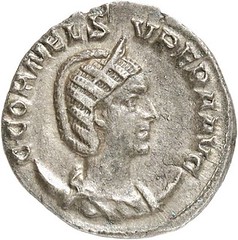
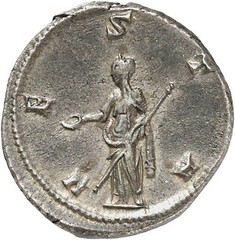
Lot 8922: ROMAN IMPERIAL TIMES. Cornelia Supera. Antoninianus, Rome. Ex NAC Auction 15 (1999), 442. Very rare. Good very fine. Estimate: 10,000,- euros
Lot 8969: ROMAN IMPERIAL TIMES. Crispus. Solidus, 324, Nicomedia. Mazzini Coll., Vierordt Coll., ex Schulman Auction (1923), 2694. Extremely rare. Extremely fine. Estimate: 100,000,- euros
Lot 9055: MIGRATION PERIOD. Visigoths. Egica, 687-702. Tremissis, Gerunda. Schwartz Coll., ex Alde Auction (2010), 196. Very rare. Very fine to extremely fine. Estimate: 10,000,- euros
Lot 9104: BYZANTIUM. Revolt of the Heraclii, 608-610. Solidus, unknown mint. Unedited(?). Extremely rare. Nearly extremely fine. Estimate: 15,000,- euros
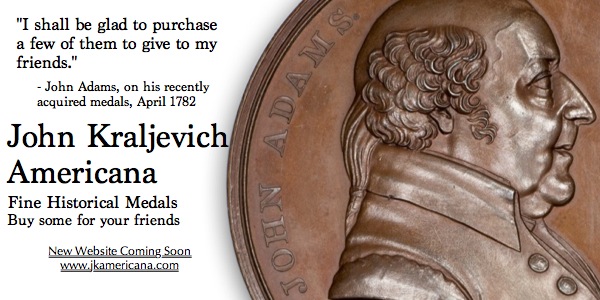
THE MYSTERY OF THE FETTER LANE HOARD
In 1908 workmen excavating foundations for a house in Fetter Lane (City of London) found 46 coins in a pot. The Rev’d FD Ringrose purchased the hoard and published an account in 1911 but focussed on describing the coins rather than the circumstances of the find. By the time the coins were bequeathed to the British Museum in 1914, there was no trace of the pot and no description of it either. There is no full account of exactly how the hoard was found and whilst Roman hoards are often uncovered in Britain (for example the Didcot, Hoxne and Beau Street hoards), the Fetter Lane hoard remains something of a mystery.
The Fetter Lane coins were all minted in Alexandria, in Egypt, between AD 58 and AD 284. At this period in the Roman Empire, official coins were produced at centrally controlled mints for use across the empire. However, many other mints also produced civic coins, usually in copper alloys, to be used in the local area. Coins had first been minted in Alexandria under the Ptolemaic dynasty (c.312–30 BC), which continued after Egypt became a Roman province in 30 BC. Unlike in most other provinces, Alexandria was a centrally controlled mint and the coins were initially made of debased silver before declining into a mainly copper alloy coinage. They circulated locally in the eastern Mediterranean and did not form part of the official Roman denomination system.

The earliest dated coin in the hoard (Year 5: 58/59 AD), depicting Nero.
Coins used in the Roman province of Britannia were from official Roman mints and we know this both from coin finds and from references to coins at the time, such as at Vindolanda. Why then would these Alexandrian coins be brought to Britain where they formed no part of the currency system?
Over the past 200 years or so when unusual coins like these have been found in Britain they have often been dismissed as modern imports, perhaps brought back to the country as souvenirs from the Grand Tour, or by soldiers returning from service. There is a long history of these finds being dismissed, particularly by coin experts in museums and universities. I am compiling a catalogue of this material to look into this question further: are coins from the Mediterranean world (and sometimes further afield) modern losses or did they arrive in Iron Age or Roman times? These are coins – minted between the 5th century BC up to the end of the 3rd century AD – which would not have been part of a currency system in Britain.
This is a particularly relevant question today when the Portable Antiquities Scheme is regularly listing coins with similar origins to the database. The steadily increasing number of ‘foreign’ coins means that it is important to readdress this question rather than dismissing it out of hand. There are examples both of coins being found in known contexts, such as in the Sacred Spring in Bath, and also where we know that coins were modern imports, such as the Alexandrian coins found on the wreck of the HMS Pomone. For the majority of coins however we have no clear information about their findspots.
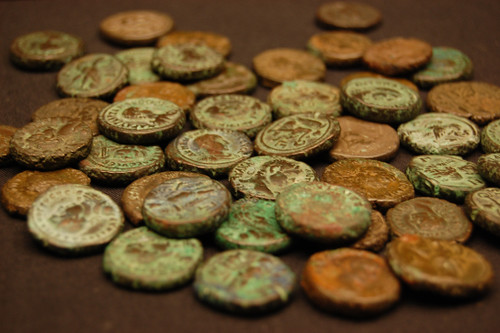
The Fetter Lane hoard is currently on display at the British Museum
To read the complete article, see:
The mystery of the Fetter Lane hoard
(http://blog.britishmuseum.org/2015/08/27/the-mystery-of-the-fetter-lane-hoard/)
LENBOROUGH ANGLO SAXON COIN HOARD ON DISPLAY
 Part of a hoard of Anglo Saxon coins found in a Buckinghamshire village is to go on display at the county's museum before its inquest
is heard.
Part of a hoard of Anglo Saxon coins found in a Buckinghamshire village is to go on display at the county's museum before its inquest
is heard.
More than 5,000 coins were found buried in Lenborough, near Padbury last year.
The find is still being catalogued by the British Museum but the coroner has given permission for "about 20 coins" to be displayed at Bucks County Museum.
A spokesman said: "It's another milestone on the path to getting them into the museum."
It is the largest Anglo Saxon coin hoard discovered since the Treasure Act was introduced in 1996 and is thought to be worth up to £1.3m. Brett Thorn, from the museum, said because there were so many coins, the cataloguing process was taking a long time and it wanted to "keep the public interested".
The 5,251 coins were found wrapped in a lead sheet by Weekend Wanderers Detecting Club member Paul Coleman, from Southampton, on 21 December.
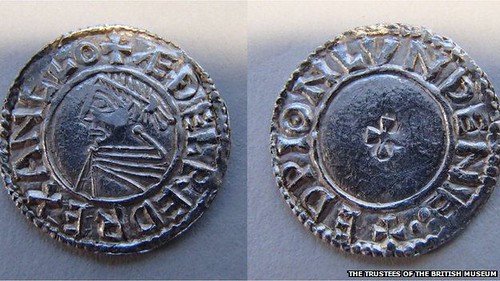
They depict the heads of kings Ethelred the Unready and Canute and come from 40 different mints around England.
To read the complete article, see:
Lenborough Anglo Saxon coin hoard to go on show
(www.bbc.com/news/uk-england-beds-bucks-herts-33987628)
RABBITS & HARES ON ANCIENT COINS

Many ancient Greek cities adopted symbolic or mythical animals as badges or totems. Athens chose the owl due to its association with Athena. Corinth chose the Pegasus. For Cyzicus in Anatolia, it was the tuna fish. And so on.
Americans have a similar custom: the dolphin for Miami, the colt for Indianapolis, the bear for Chicago. Several cities in “Magna Graecia” (the region of southern Italy and Sicily settled by Greek colonists beginning in the eighth century BCE) adopted the leaping hare as a distinctive symbol on their classical-era coinage.
 The story begins with Anaxilas, son of Cretines. In 494 BCE he seized power at Rhegium (or Rhegion, known today as Reggio Calabria at the
tip of the boot of Italy) and soon extended his rule to Sicily. Anaxilas is credited with importing Greek hares to Sicily for the aristocratic sport
of hunting. A leaping hare appears on his small silver litra at Rhegium as early as 480 BCE.
The story begins with Anaxilas, son of Cretines. In 494 BCE he seized power at Rhegium (or Rhegion, known today as Reggio Calabria at the
tip of the boot of Italy) and soon extended his rule to Sicily. Anaxilas is credited with importing Greek hares to Sicily for the aristocratic sport
of hunting. A leaping hare appears on his small silver litra at Rhegium as early as 480 BCE.
When his mule-chariot (biga) team won in the Olympic games, he placed that image on his coins. Coinage is conservative, and this basic design – mule chariot obverse, leaping hare reverse – was continued for generations.
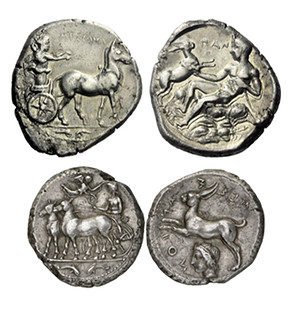 Neighboring cities that allied with Rhegium or came under its control soon adopted the leaping hare as a symbol, notably Messana. Early
coinage of Messana closely copied Rhegium’s design, changing only the “ethnic” (the inscription giving the name of the city). About 420 BCE, Messana
issued a magnificent silver tetradrachm depicting the nature god Pan, seated on a rock playing with a leaping hare[1]. Another tetradrachm from this
period shows the hare leaping over a head of Pan.
Neighboring cities that allied with Rhegium or came under its control soon adopted the leaping hare as a symbol, notably Messana. Early
coinage of Messana closely copied Rhegium’s design, changing only the “ethnic” (the inscription giving the name of the city). About 420 BCE, Messana
issued a magnificent silver tetradrachm depicting the nature god Pan, seated on a rock playing with a leaping hare[1]. Another tetradrachm from this
period shows the hare leaping over a head of Pan.
To read the complete article, see:
Bunny Money: Rabbits and Hares on Ancient
Coins (www.coinweek.com/ancient-coins/bunny-money-rabbits-hares-ancient-coins/)
THE COLLECTIONS EMERGENCY RESPONSE TEAM
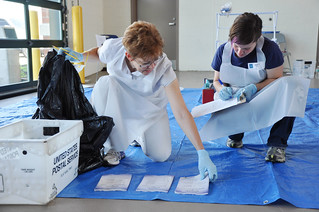 You’ve got a muddy 18th century chest of drawers. Who you gonna call?
You’ve got a muddy 18th century chest of drawers. Who you gonna call?
The American Institute for Conservation Collections Emergency Response Team, also known as AIC-CERT.
Okay, it’s not quite as catchy as Ghostbusters. But for workers at cultural institutions, the AIC-CERT is a disaster relief A-Team, solving problems ranging from a a burst pipe to a tsunami. They can be the difference between saving a collection or losing millions of dollars and priceless cultural history.
The AIC-CERT team was born out of an informal effort organized to help museums, libraries, archives and historic sites on the Gulf Coast in the wake of Hurricane Katrina, whose 10th anniversary is this year. Teams of volunteers were spending weeks at a time helping organizations assess damage and salvage collections. Afterwards, the Foundation of the American Institute for Conservation (FAIC), a national organization devoted to the preservation of cultural materials based in Washington D.C., decided to convene an official emergency response unit.
In 2007 they trained an initial team of 63 people, adding another 42 members in 2011. There are conservators, archivists, curators and architects among their ranks with specialties ranging from care of furniture to paintings. The teams are distributed throughout the country, and can be reached by a 24-hour hotline. They often work in a supervisory role, providing advice over the phone or by email, but also respond on the ground. Funded through donations and grants, their services are free. AIC-CERT crews have assisted in the aftermath of the Haiti earthquake, Hurricane Ike, and the Minot, ND floods.
After Superstorm Sandy swept through New York, they established a temporary cultural recovery center in Brooklyn where teams of volunteers cared for over 3,000 works of art, many from individual artists whose studios and storage areas were flooded.
Katrina was a “wake up call” says Barbara Moore, a 3D object conservator and AIC-CERT member and trainer who advises institutions on how to plan for disasters and teaches disaster response workshops. “I think it’s become much more real,” says Moore, who has taught workshops at the Metropolitan Museum of Art, the Los Angeles County Museum of Art, The National Museum of Natural History and the Smithsonian.
While the general public may be drawn to dramatic tales of rescue, Moore and others interviewed for this story stressed that preparedness is key. Getting organizations to assess risk and create a comprehensive disaster plan is the most important step to emerging from a crisis with a collection intact. Taking steps as simple as compiling contact numbers and making connections with state and local officials is just as important as the actual response and recovery . The Ohr O’keefe Museum in Mississippi in Biloxi, MS is often cited as a success story—they transported many holdings to safe ground before Katrina’s flood waters arrived.
To read the complete article, see:
WHEN DISASTER STRIKES, MUSEUMS CALL IN THE
A-TEAM (www.atlasobscura.com/articles/when-disaster-strikes-museums-call-in-the-ateam)

RADAR USED IN NAZI GHOST TRAIN HUNT
A Nazi gold train has been found in Poland after the man who helped hide it at the end of the Second World War revealed its location in a deathbed confession.
Two men, a German and a Pole, last week claimed they had found the train - believed to contain treasure - close to the small town of Walbrzych in south-west Poland.
 Today, Poland’s Culture Ministry announced that a man who helped hide the train had revealed its location shortly before he died.
Today, Poland’s Culture Ministry announced that a man who helped hide the train had revealed its location shortly before he died.
Speaking at a press briefing in the capital Warsaw this afternoon, Piotr Zuchowski, Poland’s National Heritage and Conservation Officer, said: 'Information about where this train is and what its contents are were revealed on the deathbed of a person who had knowledge of the secret of this train.'
He added that Polish authorities had now seen evidence of the train’s existence in a picture taken using a ground-penetrating radar.
He said the image - albeit blurred - showed the shape of a train platform and cannons.
Mr Zuchowski said the find was 'unprecedented', adding: 'We do not know what is inside the train.
'Probably military equipment but also possibly jewellery, works of art and archive documents.
'Armoured trains from this period were used to carry extremely valuable items and this is an armoured train, it is a big clue.'
He said authorities were now '99 percent sure the train exists' and whatever is on it will be returned to the rightful owners, if they can be found.
'We will be 100 per cent sure only when we find the train,' Mr Zuchowski added.
Walbrzych regional authorities will conduct the search using military explosives experts, in a procedure that will take 'weeks', he said. However, the two men who claim to have discovered the train had demanded a ten per cent finders fee of the value of whatever may be on it.
To read the complete article, see:
Nazi gold train is FOUND: Deathbed confession leads treasure hunters to secret location as Polish officials claim they have seen proof on
radar
(www.dailymail.co.uk/news/article-3214265/Nazi-gold-train-Deathbed-confession-leads-treasure-hunters-secret-location-Polish-officials-claim-seen-proof-radar.html)
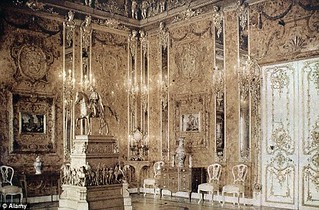 Journalist Tom Bower, who wrote Nazi Gold: the Full Story of the Fifty-Year Swiss-Nazi Conspiracy to Steal, has said he believes
there is a high likelihood the hidden locomotive is filled with art and precious jewels, rather than bars of gold.
Journalist Tom Bower, who wrote Nazi Gold: the Full Story of the Fifty-Year Swiss-Nazi Conspiracy to Steal, has said he believes
there is a high likelihood the hidden locomotive is filled with art and precious jewels, rather than bars of gold.
But what he really hopes to find in the train discovered abandoned in a tunnel underneath a Polish mountain is the Amber Room, stolen from the Catherine Palace, near St Petersburg, in about 1941.
Speaking to Sky News, Mr Bower said: 'If it is an art train, there will be paintings, there will be perhaps diamonds, there will be rubies and precious stones and also, the one thing that's always been missing, the Amber Room.
'I think it is far more exciting to think perhaps that is in the train.'
To read the complete article, see:
Nazi gold train could contain ornate £250m 'Amber Room' given to Tsar Peter the Great by the King of Prussia - and missing since it
was looted during WWII
(www.dailymail.co.uk/news/article-3215299/Nazi-gold-train-contain-ornate-250m-Amber-Room-given-Tsar-Peter-Great-King-Prussia-missing-looted-WWII.html)
To read the earlier E-Sylum article, see:
HAS LEGENDARY NAZI GHOST TRAIN BEEN FOUND?
(www.coinbooks.org/esylum_v18n34a26.html)
TOLEDO RETURNS TO COIN PARKING METERS
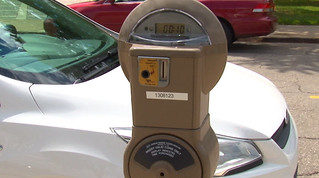 People parking in downtown Toledo may have noticed a change to some of the parking meters.
People parking in downtown Toledo may have noticed a change to some of the parking meters.
Drivers used to pay at a nearby kiosk, called “pay and display.” with change or a credit card. They would then put the receipt on their dashboard.
Only four kiosks were needed to cover about 32 spaces on Constitution and Speilbusch.
But now, Park Smart, the company that handles parking in the area, is making a change.
The company is reverting back to the old coin-operated single-space meters.
After a 10-year run, Park Smart says they were at the end of their life. Toledo’s cold winters have damaged the meters.
Since the cost of replacing them would be about $50,000, the company has decided to make the switch.
“The choices are based on two: the cost and the customer experience. And also just following industry trends, and one is moving away and it just happened to be that ours were at end of life,” said the Vice President of Park Smart, Dan Fortenberry. “Probably half of our meters in Toledo also are the credit card accepting single space meters. And that's the way the industry's going.”
Fortenberry said the company wants to still offer customers different ways to pay. He says its actually easy for them to allow customers to use credit cards because there’s less cash to be handled that way.
With the meter switch, customers will still be able to pay without coins. The Park Smart meters will be equipped with a pay-by-phone feature.
To read the complete article, see:
Coin-operated meters are back in
downtown Toledo (www.toledonewsnow.com/story/29877510/coin-operated-meters-are-back-in-downtown-toledo)
CHINESE UNDERGROUND CASH STASH TURNS TO MUSH
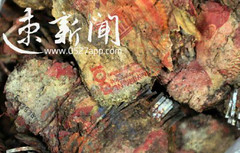 According to Mr. Zhang, more than four years ago, his mom wrapped the stacks of banknotes in a plastic bag and stored them in an iron box
before deciding to keep them under the floor of her kitchen. This past April, when Mr. Zhang was getting married, his mother finally remembered about
the 100,000RMB she'd left buried underground.
According to Mr. Zhang, more than four years ago, his mom wrapped the stacks of banknotes in a plastic bag and stored them in an iron box
before deciding to keep them under the floor of her kitchen. This past April, when Mr. Zhang was getting married, his mother finally remembered about
the 100,000RMB she'd left buried underground.
She hurried to dig up the money, hoping to provide a beautiful wedding for her son. But to her surprise, the money had essentially turned to mush and crumbled when she touched it.
Mr. Zhang sought help at the local Bank of China location. A damaged banknote appraiser surnamed Lin told him that based on the current exchange rate, he was not going to get 100,000RMB for his mash of money. After taking pictures of the banknotes, Lin said that he would help Mr. Zhang contact the bank in Nanjing for further evaluation.
Similar incidents have actually occurred before. Last July, a Guangdong migrant worker in his 60s tragically found that the 80 thousand yuan he'd stored in his shed had been eaten by termites to half of the original amount.
To read the complete article, see:
Jiangsu villager hides 100,000RMB in banknotes underground for 4
years, cash turns to mush (http://shanghaiist.com/2015/08/30/money_turns_to_mush.php)
FEATURED WEB PAGE: RUSSIAN PAPER MONEY
This week's Featured Web Page is Viola's page on the History of Russian Paper Money. It doesn't have much information, but the images are gorgeous.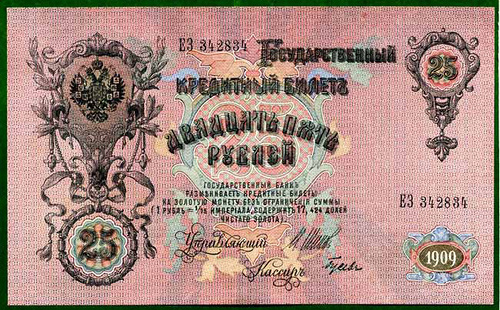
http://viola.bz/history-of-russian-paper-money/
